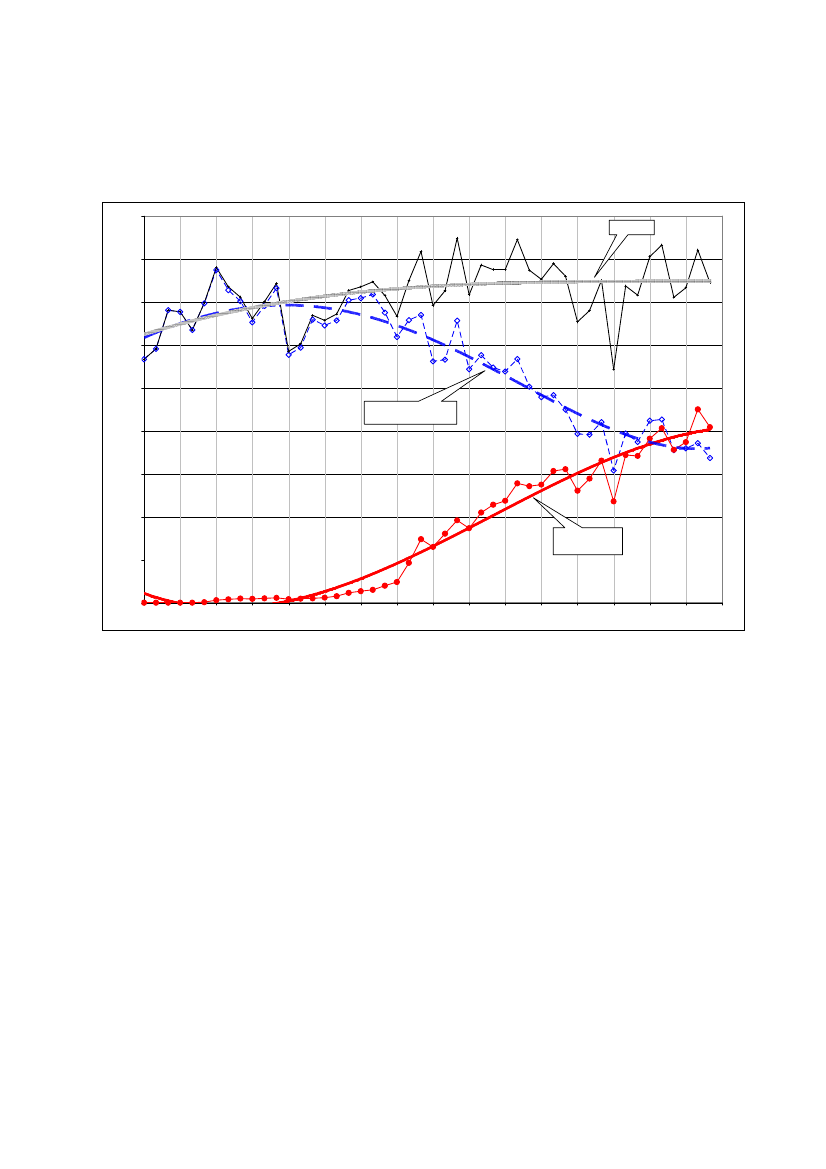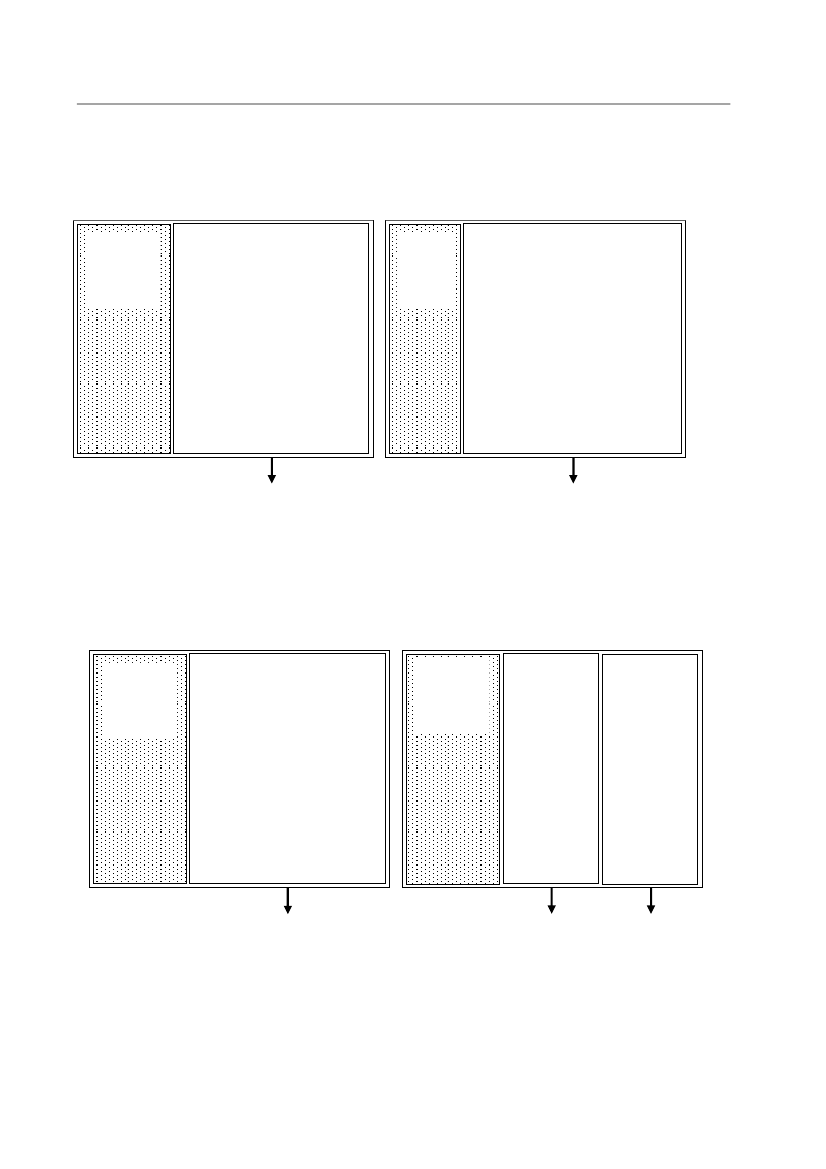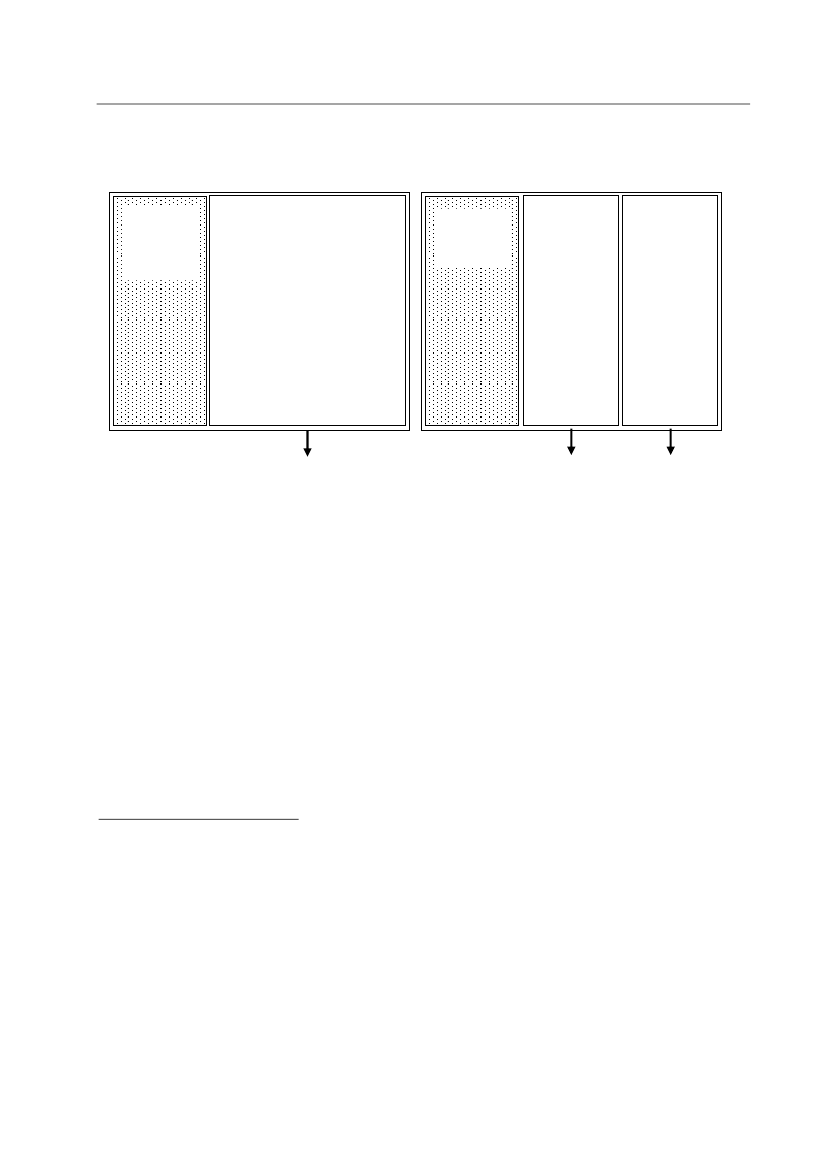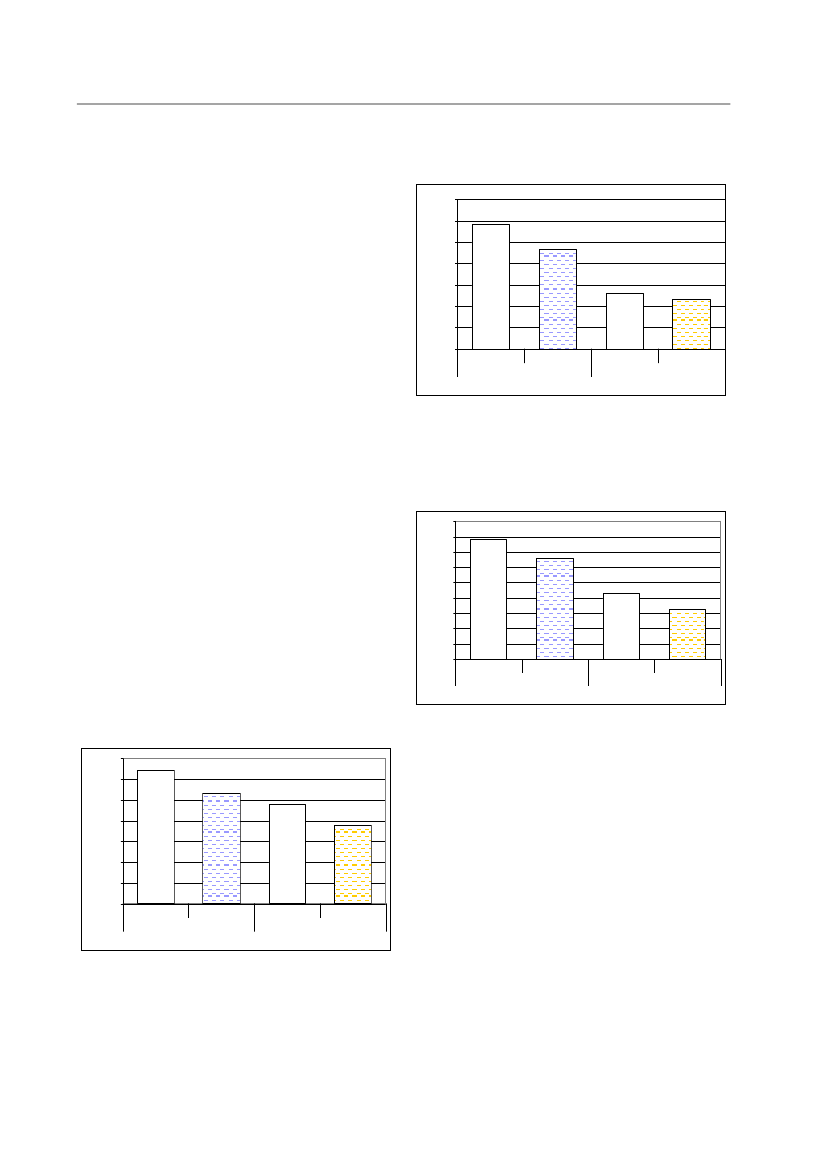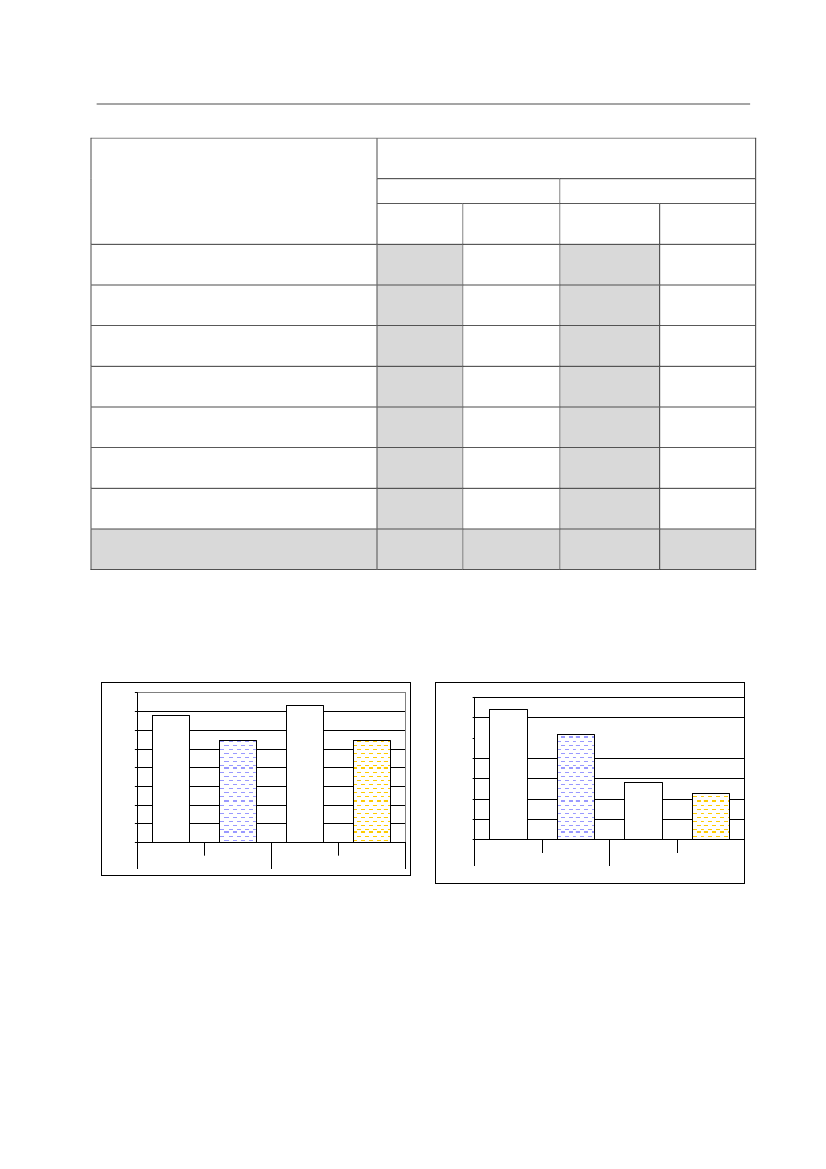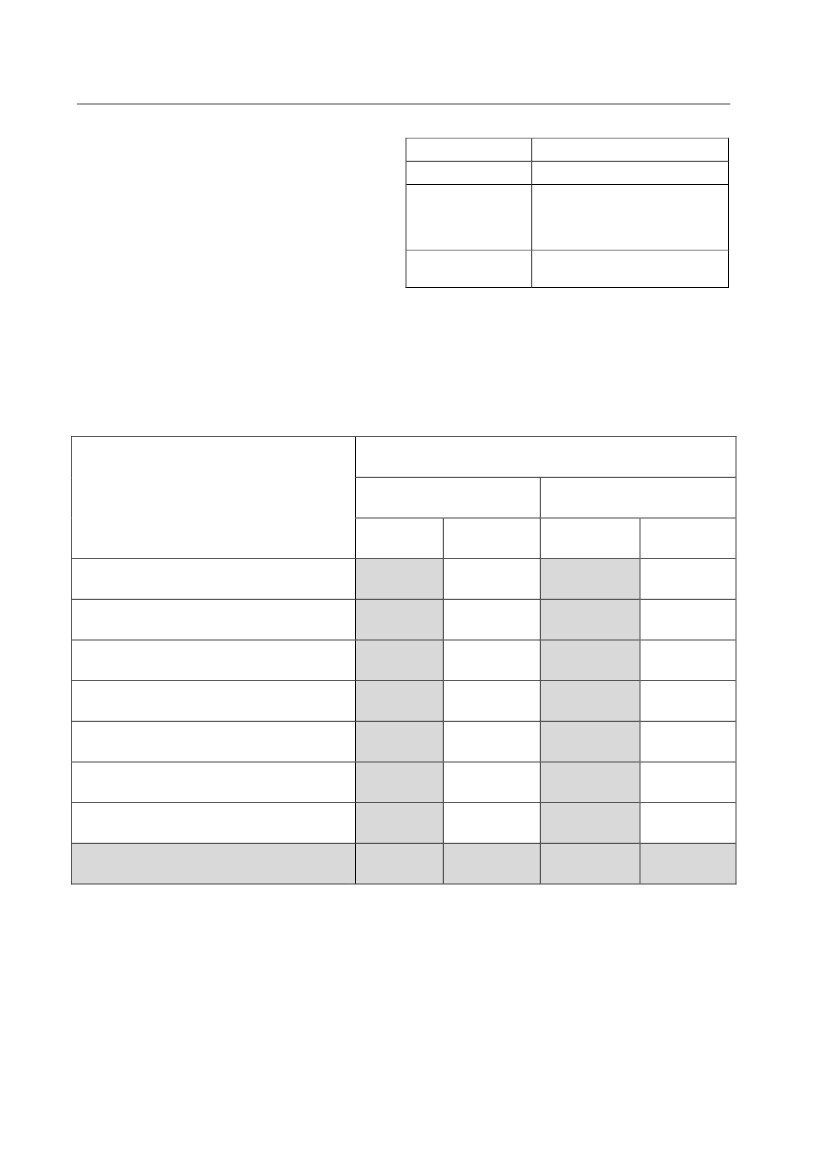Retsudvalget 2013-14
B 23 Bilag 1
Offentligt
Evaluation of the novice driver training models“Accompanied driving from 17” and “Voluntary furthertraining seminars for holders of probationary drivinglicences”. Results up to November 2009.
Georg Willmes-Lenz, Frank Prücher, Heidrun Großmann
Third report on AP project F1100-4408016 “Evaluation of novice driver training models”
Federal Highway Research Institute, Section U4 “Driver Training, Driver Improvement”Bergisch Gladbach, 31.05.2010 (expanded version)
Contents
1. Introduction2. Practical implementation of the VFT model: Results of the process evaluation2.1 Objective2.2 Method2.3 Results2.4 Significance of the results
355557
3. Road safety effectiveness of the VFT model: Results of the summative evaluation3.1 Objective3.2 Method3.3 Results3.4 Significance of the results
888911
4. Participation figures and road safety effectiveness of the VFT model: Evaluation ofVZR and ZFER data records4.1 Objective4.2 Method4.3 Results4.4 Significance of the results
1111111214
5. Practical implementation of the AD17 model: Results of the process evaluation5.1 Objective5.2 Method5.3 Results5.4 Significance of the results
1515161623
6. Road safety effectiveness of the AD17 model: Results of the summative evaluation6.1 Objective6.3 Studies presented to date6.3 Results6.4 Significance of the results
2323232426
7. Conclusion8. BibliographyAnnexSchade, F.-D., Heinzmann, H.-J. (2009). Summative Evaluation of Accompanied Driving from 17.Special evaluation: First evaluation results on the basis of self-reported driving behaviour.
272930
2
1. IntroductionThe present report is a compilation of the evaluation results obtained by the end of 2009 inrespect of the experimental novice driver training models “Voluntary further training semi-nars for holders of probationary driving licences” (here: “VFT model”) and “Accompanieddriving from 17” (here: “AD17 model”). These models were initially introduced on a trial ba-sis in 2003 and 2005, respectively, and are to be evaluated and tested with regard to theirroad safety effectiveness before the government makes a decision on permanent integrationinto the driver licensing system.Alongside the question of road safety effectiveness (summative evaluation), the studies arealso to analyse the experience gained from practical implementation of the individual con-cepts (process/formative evaluation). Whereas the safety impact is of direct significance forthe decision on permanent adoption of the models, the results of the process evaluation areimportant independently of this decision for considerations of the possibilities for conceptoptimisation.The evaluation studies conducted by the Federal Highway Research Institute (BASt) werespread over a total of six sub-projects. These sub-projects are listed in Tab. 1, together withan indication of the precise subject of evaluation and the methodical approach. Completeand conclusive results are available from five of these sub-projects.In the case of the summative evaluation of the AD17 model, it is currently only possible topresent partial results, due to the specific project schedule dictated by the analysis design.These results are available in the form of an intermediate report dated 31.07.2007 (Schadeet al., 2007) and a special evaluation dated 30.11.2009 (Schade & Heinzmann, 2009). With itsanalysis of the safety-related behaviour of novice drivers during their first year of independ-ent driving on the basis of self-reported accident involvement and traffic offences, the latterreport covers an important aspect of the overall project objective. Given the conclusive char-acter of the partial results from this special evaluation, it is already possible to make a soundassessment of the road safety effectiveness of the AD17 model at the present juncture.Statements on the road safety effectiveness of the AD17 model are also to be found in anevaluation of the University of Giessen, which investigates the impact of the experimentalscheme of accompanied driving as initially implemented at regional level in the federal stateof Lower Saxony (Stiensmeier-Pelster, 2008). The corresponding results have been incorpo-rated into the appropriate section of the present report.The Federal Highway Research Institute (BASt) intends to publish the research results fromthe individual evaluation projects in the form of scientific reports (M series “People andSafety”), so as to make the findings available in their full scope for the pending traffic policydiscussions and for the further professional treatment of issues concerning safety-relatednovice driver preparation. It is expected that the reports on the evaluation projects whichhave already been completed will be published in the first months of the coming year. Thepublication of the final research report on the road safety effectiveness of the AD17 model,on the other hand, will not be possible until the corresponding behaviour-relevant data havebeen acquired and evaluated in full, presumably in autumn 2010. For this reason, and in theinterest of early and comprehensive information, the special evaluation already completed inadvance on 30.11.2009 has been appended to the present report in its full version.
3
ProjectFE 82.264/2004Evaluation of voluntaryfurther training seminarsfor novice drivers (VFT).Formative evaluation.Project supervision:Dr. Hartmut Kerwien,BielefeldFE 82.307/2006Evaluation of voluntaryfurther training seminarsfor novice drivers (VFT).Analysis of effectiveness.Project supervision:Centre for Evaluation andMethods (ZEM), BonnFE 89.226/2009Evaluation of voluntaryfurther training seminarsfor novice drivers (VFT),based on VZR data records.Project supervision:Federal Motor TransportAuthority, Statistics Dept.,Group 31, FlensburgFE 82.298/2005Accompanied driving from17. Process evaluation.Project supervision:Institute for EmpiricalSociology (IfeS), NürnbergFE 89.221/2009Designing of accompanieddriving practice.Project supervision:Institute for EmpiricalSociology (IfeS), NürnbergFE 82.316/2006Accompanied driving from17. Summative evaluation.Project supervision:Federal Motor TransportAuthority, Statistics Dept.,Group 31, Flensburg
CompletionEnd 2009
Evaluation topicPracticalimplementation ofthe VFT model
MethodAnalysis of concept-adequateimplementation of the modelon the basis of surveys andseminar observations
End 2009
Road safetyeffectiveness of theVFT model
Evaluation of model-relatedchanges in road safety atti-tudes with the aid of psycho-logical attitude measurementswithin the framework of apre-post comparison with acontrol group
End 2009
Road safetyeffectiveness of theVFT model
Determination of the scope ofuse of the model and compari-son of the driving behaviour ofVFT participants and non-participants of similar age andexperience on the basis of ZFERand VZR data records
End 2009
Practicalimplementation ofthe AD17 model
Analysis of concept-adequateimplementation of the modeland general practical experi-ence, based on the questioningof participating novice driversand accompanists, as well asdocument analysesDeeper analysis of the inter-action between novice driversand their accompanists on thebasis of surveys
End 2009
Practicalimplementation ofthe AD17 model
30.09.2010Partialresults:31.07.200730.11.2009
Road safetyeffectiveness of theAD17 model
Evaluation of the model-specific reduction in accidentand traffic offence risks on thebasis of a comparison of therates of accident involvementand traffic offences betweenAD17 participants and conven-tionally trained novice drivers
Tab. 1: BASt evaluation projects addressing the novice driver models “Voluntary furthertraining seminars for novice drivers” and “Accompanied driving from 17”4
2. Practical implementation of the VFT model: Results of the processevaluation2.1 Objective“Voluntary further training seminars for novice drivers” (VFT model) were introduced on a trial basisby way of the Novice Driver Further Training Ordinance (Fahranfängerfortbildungsverordnung,FreiFortbV) of 16th May 2003. In §6 of this ordinance, it is specified that the Federal Highway Re-search Institute (BASt) is to evaluate the model to assess the “effectiveness with regard to roadsafety”. The individual topics and procedures for the evaluation were discussed in advance of theintroduction between the BASt and protagonists with practical interests, e.g. the German Road Safe-ty Council (DVR), the driving instructors and the German motorists' association ADAC, and agreed asfollows: A first evaluation stage was to address questions concerning the functioning of the model,participation patterns, participant motivation and acceptance (process evaluation). Subsequently,the impact of the model approach on road safety was to be investigated as a second stage (summa-tive evaluation).The principal objective of the VFT model is to influence youth-specific attitudes and risk-related be-haviour by way of educative measures. The intervention is aimed at modification of the young driv-ers' value systems, attitudes and convictions to the benefit of road safety. The seminar leaders andmoderators are expected to realise the affective, i.e. attitude-related learning objectives throughforms of interaction which demand active contributions by the participants. This is to be achievedwithin the framework of group discussions, observed driving practice and practical safety training.The objective of the formative evaluation is to describe and analyse the practical implementation ofthe model under the aspect of concept-adequate realisation.2.2 MethodThe empirical analysis of practical implementation was founded on three study approaches:-Partially structured observations, interviews and written questionnaires to acquire the assess-ments and experience of the VFT seminar leaders and the moderators of the module “Practicalsafety training”.Questionnaire survey of the VFT participants to acquire their view of the VFT programme mod-ules.Structured descriptions of the seminar realisation on the basis of participative observations andinterviews conducted by specially trained survey researchers.2.3 Results2.3.1 Questioning of seminar leaders and moderatorsThe seminar leaders and safety training moderators shared the opinion that the limited response tothe model was in part due to the voluntary nature of VFT participation. Its awareness level was seento be inadequate and the costs deterred potential participants. The shortening of the probationaryperiod was perceived as the predominant motivation for the participation of the novice drivers.2.3.2Questioning of participants
--
The questionnaires completed by the participants confirmed that the prime motivation for participa-tion was the shortening of the probationary period, followed by an expectation of improved driving5
competence. Female participants replied far more often than their male counterparts that theywanted to learn to drive more safely and overcome driving anxieties. Participants under extendedprobation were even more distinctly attracted by the opportunity to shorten the probationary pe-riod, and were significantly less interested in learning to drive safely or improve their driving skills.The seminar module “Practical safety training” received the best marks in all assessment categories.The participants reported that the practical safety training had brought them the greatest benefits,that it had been more fun than the remaining modules, that it had offered the most valuable con-tents, that it had best met their expectations, and that it had been most interesting.In the opinion of the participants, the seminar leaders spoke too much about their own experiencesduring the group discussions. Otherwise, the seminar leaders and moderators received positive as-sessments.2.3.3Seminar observations
The seminar observations served to assess the degree of goal accomplishment of the individual pro-gramme modules. The first group discussion achieved the best result with an assessed goal accom-plishment of 75 per cent. It was already indicated during these first discussions, however, that thelinking of the individual seminar modules was problematical. This applied above all to elaboration ofthe group's wishes concerning the observed driving practice and the practical safety training. A fur-ther problem was identified in time management. At the beginning of the first group discussion, inparticular, considerable time was spent on organisational questions.Compared to the first group discussion, the second and third group discussions displayed a numberof realisation deficits. The degree of goal accomplishment for the second module was assessed at 62per cent by the observers, and the third module was deemed to be only marginally better with adegree of goal accomplishment of 64 per cent.During the second group discussions, it was recognised that problems arose with regard to commu-nication of the psychological topics “Driving motives” and “Emotions”. The aspects of (a) the impactof emotions on attentiveness, (b) the correlation between emotions and competitive behaviour, and(c) the impairment of personal safety by emotions and time pressures, in particular, could not beconveyed adequately in numerous discussions. The interlinking seminar elements were also ne-glected somewhat during the second group discussion, and there were again certain problems withtime management.The seminar leaders devoted the attention of the third group discussion above all to the topic of“Avoiding driving under the influence of alcohol or drugs”, and this was for the most part also treatedadequately in the sense of the model concept. Nevertheless, it was conspicuous that the participantswere not always able to formulate corresponding strategies to avoid driving under the influence ofalcohol or drugs. It was often not possible to convince the participants to maintain behaviour pat-terns recognised as sensible in the future.Generally, it was shown that a review of previous group discussions was for the seminar leaders lessimportant than the retrospective contemplation of practical elements.The objectives of the module “Observed driving practice” were considered achieved to an extent ofalmost 70 per cent (with the exception of the element “Modern driving”, which the observers ratedwith a degree of goal accomplishment of 58 per cent). The realisation of the exercise component wasessentially satisfactory, although only few participants specified actual exercise situations. On theother hand, this aspect was frequently linked with the topic of ecological driving, which involved6
above all the provision of tips on a fuel-saving driving style. Primarily safety-relevant driving tips weregiven less emphasis.The practical safety training achieved a degree of goal accomplishment of only 64 per cent, the sec-ond-lowest value of all modules. The whole thematic element “Braking” was handled in an extremelydiverse manner, and in some seminars deviated significantly from the specifications of the handbook.The concept adequacy of the element “Driving through curves” was criticised. The exercises weregenerally performed very hastily and were seldom clearly differentiated; in many seminars, thespeed specifications were not observed.VFT moduleDegree of goalaccomplishment75%62%64%69%64%
1st group discussion2nd group discussion3rd group discussionObserved driving practicePractical safety trainingTab. 2:
Degrees of goal accomplishment in the modules of the VFT model
2.4 Significance of the resultsIt can be seen from the results that the novice drivers valued above all those benefits of the seminarswhich corresponded to their expectations and interests: The shortening of their probationary periodand time spent on practical driving exercises.At the same time, it is evident that the seminar leaders experienced problems with the application ofactive, attitude-building training forms, and that it was the seminar element dealing with the topic ofemotions which caused them the greatest difficulties.This result also corresponds to international experience. An analysis of Swedish novice driver trainingcourses which followed an explicitly attitude-building concept, for example, revealed that the par-ticipants were later of the opinion that the course had above all served to improve their practicaldriving skills (cf. EU project ADVANCED, 2002).The evaluation report criticises the overall excessive number of specified goals for the individualseminar modules. This diversity of goals is at the same time a source of time management problems.It is suggested that the broad spectrum of learning objectives be narrowed down significantly andformed into a hierarchy of training goals, as a basis for effective implementation by the seminarleaders and moderators. In addition, thought should be given to a more streamlined timeframe.The recommendation from an expert point of view is to subject the VFT seminars to a thorough re-view in the light of the aforementioned points, referring both to the concept of the model and itsconcept-adequate implementation.
7
3. Road safety effectiveness of the VFT model: Results of the summativeevaluation3.1 ObjectiveThe summative evaluation served to analyse the model-related effectiveness of the VFT model withregard to improvements in road safety. The criterion of accident involvement, however, was dis-counted as a possible measure of road safety effectiveness in the context of a survey study, as it wasclearly foreseeable that the necessary sample size would not be attained.The objective of the VFT model is to reduce the risk of accident for young novice drivers by way of apositive influencing of road safety attitudes. The criterion chosen to verify the effectiveness of themodel, therefore, was the change in attitudes achieved through VFT participation.3.2 MethodOn the basis of the goals formulated in the VFT model handbooks, 11 road-safety-relevant attitudeswere identified and subsequently applied within the framework of the evaluation.The displayed attitudes were measured using reliability-tested attitude scales and a number of indi-vidual evaluation items on four occasions: Before VFT participation, shortly afterwards, and on twofurther occasions during the course of the subsequent year.1A reference sample of novice driverswho had not attended VFT seminars – parallelised in respect of gender, driving experience andschool education background – was analysed at the same intervals using the same instruments.It proved particularly difficult to gain the cooperation of an adequate number of study participants;recruitment was only successful thanks to the active support of driving instructors who specificallyapproached novice drivers, and through the provision of financial incentives for participation. On thebasis of an initial sample of over 1,000 persons, it was in the end possible to take the data from ap-proximately 300 persons (experimental group and control group) into account in the final evalua-tions.To verify the effectiveness of the model, the following comparative analyses were performed toevaluate the determined attitudes of the VFT participants (experimental group) and non-participants(control group):---Evaluation of the changes in displayed attitudes over the course of the measurementsComparison of the displayed attitudes of VFT participants and non-participants on each meas-urement occasionCombined evaluation of the changes between measurements and the differences between theexperimental and control groups.
The combined evaluation is necessary, as it is only on this basis that a statement can be made as towhether changes in the attitudes displayed by the experimental group – either positive or negative –can be attributed to the model intervention. A positive attitude change in the experimental group,for example, can only be interpreted as an intervention effect if no corresponding attitude change isdisplayed in the control group – given otherwise identical framework conditions.1
The following overall evaluation takes into account only the results of the first three measurements, as no adequate data-base was obtained to permit analysis of the fourth survey results.
8
The differences in attitudes were in each case tested with regard to their statistical significance, andthe corresponding effect size was determined. The influences of the individual distances driven andfurther confounding variables were checked during the evaluation.2It can be assumed that the model is effective if, after VFT participation, the attitudes of the partici-pants develop to the benefit of road safety to a significantly greater extent than those of the driversin the control group. Even in the case of overall negative changes in attitude, a model effect can stillbe assumed if the VFT participants display a more favourable development than non-participants, i.e.if the deterioration in attitudes in the experimental group is less pronounced than in the controlgroup.On this basis, the following three questions or hypotheses were considered:(1) Pre-post comparison: Do the VFT participants display improved attitudes after participation?(2) Absolute comparison of VFT participants and non-participants: Do the VFT participants displaymore favourable attitudes than the control group after participation?(3) Relative comparison between VFT participants and non-participants: Do the VFT participantsdisplay more favourable road-safety-relevant attitudes than the control group over the wholecourse of the measurements (irrespective of generally declining values)?3.3 ResultsThe individual safety-relevant attitudes and competence indicators listed in Tab. 3 were evaluated.For the majority of the attitudes and competence indicators considered, no evidence of influenceattributable to VFT participation was found.Partial indications of a positive effect of VFT participation were revealed merely in the attitude do-mains risk-taking disposition and hazard awareness, but could not be substantiated in the overallevaluation.Risk-taking disposition: Viewed over the whole course of the measurements, both the experimentalgroup and the control group displayed a perceptible increase in risk-taking disposition. In the isolatedevaluation of the third set of measurements, it was to be seen that the risk-taking disposition of theVFT participants was at this time slightly, but nevertheless significantly less distinct than in the con-trol group. This could be interpreted as a (medium-term) effect of the model. The extent by whichthe increase in risk-taking disposition is lessened due to VFT participation, however, is so small that itis not possible to assume a significant influence on risk-taking disposition.Hazard awareness was already more pronounced in the experimental group than in the controlgroup before participation in VFT seminars. At the time of the second survey, i.e. immediately afterVFT participation, on the other hand, no differences were to be determined between the groups. Theresults of the third measurement, finally, again showed a significantly greater hazard awarenessamong the VFT participants than in the control group. This difference, however, could be attributablenot only to the VFT participation in the sense of a medium-term effect, but also to the differenceswhich already existed at the time of the first measurements. Nevertheless, as the statistical effect
2
The post-hoc tests took the form of either t-tests for independent samples or variance analyses for independent samples(ANOVA) with Bonferroni tests. The measure for the effect size was Cohen's d in the case of the t-tests and partial eta-2squared (η ) in the case of the variance analyses. To evaluate the differences in the development of displayed attitudesbetween the experimental and control groups, variance analysis with repeated measurements was used.
9
size at the time of the third survey was found to be significantly greater than at the time of the firstsurvey, model effectiveness can be assumed for this attitude domain.The VFT participants also displayed a significant change in their self-assessment of safety-relevantdriving competence over the course of the measurements. There was a significant increase betweenthe first and third surveys. As this same phenomenon was observed in the control group, however, itis not justified to conclude that the model is effective in this respect.In all other attitude and competence constructs taken as criteria to verify the effectiveness of theVFT seminars, no hypothesis-relevant results were recorded.
HypothesisAttitude scales/items1.2.3.4.5.Personal importance of driving (Scale B)Realistic assessment of traffic demands (Scale C)Readiness to observe traffic rules (Scale D)Risk-taking disposition/risky behaviour (Scale E)Adequate self-assessment with regard to driving ability in different complex drivingsituations (Scale F)Reflection of own driving behaviour (Scale G)Reflection of driving behaviour with regard to vehicle control (Scale G1)Reflection of driving behaviour with regard to incorrectly observed traffic situations(Scale G2)Reflection of driving behaviour with regard to influences arising from accompanyingcircumstances (Scale G3)Reflection of driving behaviour with regard to influences arising from moods and emotions(Scale G4)Hazard awareness (Scale H)Risk avoidance (Scale I)Locus of control (Scale J)Assessment of own safe driving behaviour (Scale K)1. Critical assessment of general driving ability (Item L1)2. General admission of driving competence deficits (Item L2)3. General assessment of driving competence with reference to safe driving (Item L3)
(1)n.s.n.s.n.s.n.s.n.s.n.s.n.s.n.s.
(2)n.s.n.s.n.s.≤ .05n.s.n.s.n.s.n.s.1
(3)n.s.n.s.n.s.n.s.n.s.n.s.n.s.n.s.
6.6.1.6.2.
6.3.
n.s.
n.s.
n.s.
6.4.
n.s.n.s.n.s.n.s.n.s.n.s.n.s.≤ .001
n.s.≤ .05n.s.n.s.n.s.n.s.n.s.n.s.1
n.s.n.s.(–)(–)n.s.n.s.n.s.n.s.
7.8.9.10.11.
Hypotheses:(1) = VFT participants display improved attitudes after participation.(2) = VFT participants display more favourable attitudes than the control group after participation.(3) = VFT participants display more favourable attitudes than the control group over the whole course of the measurementsn.s = Result not significant, hypothesis must be rejected; ≤.05 = Hypothesis confirmed with p ≤ .05; ≤ .001 Hypothesis con-firmed with p ≤ .001; (–) = Hypothesis was not tested1
Referring to significant differences between participants and non-participants at the time of the third measurement.
Tab. 3: Results of hypothesis testing in the summative evaluation of the VFT model
10
3.4 Significance of the resultsViewed on the basis of the results of the present evaluation, the VFT model has failed to developrelevant effectiveness with regard to the whole spectrum of attitudes addressed by the programme.An attitude effectiveness is only revealed partially and to a minor extent at certain points: The resultspoint to effects for particular individual aspects in only two of eleven attitude domains.Given the present results, it is not possible to attribute a sustained preventive effectiveness to theVFT model in the sense of an improvement in road-safety-relevant attitudes. Against this back-ground, it is rather inconceivable that the VFT model will be able to achieve more than just marginalchanges in the driving behaviour of novice drivers.The evaluation results are not essentially different to those obtained in conjunction with the compa-rable preventive programme “Jugend fährt sicher” ("Young people driving safely”) and already pre-sented in the past (cf. Schulz et al., 1995).The repeated failure to supply proof for the effectiveness of attitude-related supplementary trainingoffers for novice drivers in the form of VFT seminars or the earlier “Jugend fährt sicher” coursesshould give cause for a fundamental reappraisal of the existing concepts for attitude-related inter-vention addressing novice drivers. At the same time, it should be kept in mind that, alongside drivingexperience deficits, age- and novice-typical attitudes are decisive factors contributing to the above-average accident risk of young and novice drivers, and that the development of effective preventionconcepts in this field is of major importance for road safety.
4. Participation figures and road safety effectiveness of the VFT model:Evaluation of VZR and ZFER data records4.1 ObjectiveThe objective of this study was to determine the scope of utilisation of the model and to assess theroad safety effectiveness of the VFT model through a comparison of the safety-relevant driving be-haviour of VFT participants and non-participants of the same age and with similar driving experience3on the basis of corresponding data records retrieved from the Central Register of Traffic Offenders(VZR) at the Federal Motor Transport Authority (KBA) in Flensburg.4.2 MethodThe number of drivers participating in the VFT model was determined on the basis of data retrievedfrom the Central Register of Driving Licences (ZFER), which is similarly maintained by the FederalMotor Transport Authority in Flensburg. The attributes gender, age, federal state of the responsiblelicensing authority, and probation status before participation were recorded in each case.Data on relevant traffic behaviour were retrieved from VZR data records for both VFT participantsand non-participants – parallelised according to gender, age, federal state and duration of the proba-tionary period before the start of the present observation.The VFT participants formed the experimental group (E), further sub-divided into persons with a two-year probationary period (E2) and those with an extended probationary period (E4). The survey cov-
3
Measured by the duration of driving licence possession
11
ered all VFT participants who could be contacted (full sample). Under the given basic scheduling, itwas possible to include practically the whole population of participants from the year 2007.Novice drivers for whom no VFT participation had been recorded since the granting of a class B or BEdriving licence were assigned to the control group (C), with a corresponding sub-division into C2 andC4 in accordance with their probation status. The persons actually forming the control groups wereselected by way of stratified random sampling.On the basis of personal identification data, the individual records held in the Central Register ofTraffic Offenders were retrieved for all persons assigned to the experimental (E) and control (C)groups (N = 11,780) on two dates, namely on 18.01.2009 (to forestall the possible deletion of olderoffences from the register) and on 02.08.2009. The register numbers of unambiguous query resultswere listed and the automated VZR statistics database was searched for entries between 2007 andthe survey date in 2009 on the basis of these register numbers. All data records retrieved in this waywere listed and subsequently processed to ensure unambiguous assignment to the sample. From thisdata pool, which comprised all VZR records pertaining to E and C group members, a subset wasformed containing the entries which referred to traffic offences which had been committed duringthe observation period, but at the same time also entered in the register at the latest 18 monthsafter the start of the probationary period. These VZR records were subjected to thorough plausibilitychecks and categorised dichotomously according to their references to the catalogue of traffic of-fences and/or accident indicators.4.3 Results4.3.1 Scope of participation in the VFT modelEver since introduction of the VFT model in 2004, participation has remained at a distinctly low levelof significantly less than one per cent of the persons granted a class B/BE driving licence. Tab. 4 pro-vides an overview of the participation in the years 2004 to 2008, compiled on the basis of an analysisof amendment notices submitted to the Central Register of Driving Licences at the Federal MotorTransport Authority by the local licensing authorities. Due to the limited participation, however, nomentionable road safety effect can be assumed for the model as a whole, irrespective of whether asignificant safety effectiveness is determined in connection with VFT participation.Year20042005200620072008VFT participants,total, N4981461231024331826VFT participants with normalprobationary period, N (%)426 (86 %)1094 (75 % )1647 (71 %)1690 (69 %)1052 (58 %)VFT participants with extendedprobationary period, N (%)72 (14 %)367 (25 %)663 (29 %)743 (31 %)774 (42 %)
Tab. 4: VFT participants in the years 2004 to 2008, categorised according to their probation statusbefore participation4.3.2Safety-relevant driving behaviour
The safety-relevant driving behaviour of VFT participants (E) and non-participants (C) is compared inTab. 5 on the basis of the assignment to different traffic offence categories in the central register.
12
For the VFT participants, the records pertaining to relevant traffic behaviour were analysed for anobservation period of one year, starting at the end of the shortened probationary period subsequentto VFT participation. In the case of non-participants, the equivalent period of time was considered.Column E shows the ratio of VFT participants with records of the specified conspicuous behaviour totheir non-participating counterparts. Contrary to expectations, the novice drivers were not found todrive more safely and with greater respect for traffic rules after VFT participation. Instead, the groupof VFT participants displayed conspicuous behaviour consistently – and in some cases considerably –more frequently than the group of non-participants.Column F indicates the tested statistical significance of the differences between VFT participants andnon-participants.AComparisonBIndicatorCE groupFreq. RecordsAbs. %1,239352.821,239665.331,23970.561,239685.491,239 1199.60355123.38355246.7635520.56355339.3035546 12.96525295.52525519.7152571.3352566 12.57525 105 20.0012364.8812364.8812300.00123118.9412319 15.45DC groupFreq. RecordsAbs. %1,239191.531,239191.531,23940.321,239181.451,239493.9535561.6935551.4135510.2835571.97355164.51525214.00525346.4852550.95525366.8652572 13.7112354.0712332.4412321.6312386.5012316 13.01ERatioE to C1.843.471.753.782.432.004.802.004.712.881.381.501.401.831.461.202.000.001.381.19FSignificance
E2-1 vs. C2-1
E2-2 vs. C2-2
E4-1 vs. C4-1
E4-2 vs. C4-2
AccidentEndangeringAlcohol/drugsSpeedingTotalAccidentEndangeringAlcohol/drugsSpeedingTotalAccidentEndangeringAlcohol/drugsSpeedingTotalAccidentEndangeringAlcohol/drugsSpeedingTotal
****n.s.******n.s.***n.s.******n.s.*n.s.****n.s.n.s.n.s.n.s.n.s.
Compared groups:E2-1: VFT participants with two-year probationary period, VFT participation in first year of probation; Start of observation: Earlier end ofprobationary period after 12 months (end of probation)C2-1: Non-participants with two-year probationary period; Start of observation: Beginning of second year of probationE2-2: VFT participants with two-year probationary period, VFT participation in second year of probation; Start of observation: Earlier end ofprobationary period after VFT participation (end of probation)C2-2: Non-participants with two-year probationary period; Start of observation: Timing analogous to E2-2E4-1: VFT participants with four-year probationary period, VFT participation in first to third year of probation; Start of observation: Earlierend of probationary period after 36 months (end of probation)C4-1: Non-participants with four-year probationary period; Start of observation: Beginning of fourth year of probationE4-2: VFT participants with four-year probationary period, VFT participation in fourth year of probation; Start of observation: Earlier end ofprobationary period after VFT participation (end of probation)C4-2: Non-participants with extended probationary period; Start of observation: Timing analogous to E4-2Indicators:A “Accident”: Culpable accidentB “Endangering”: Record of an endangering of road trafficC “Alcohol/drugs”: Record of an alcohol- or drugs-related offenceD “Speeding”: Record of a speeding offenceE “Total”: Record of any traffic offenceSignificance:Difference between E and C groups, Fisher’s exact test, unidirectional hypothesis: n.s. = not significant, * = p ≤ .05, ** p ≤ .01, *** p ≤ .001
13
Tab. 5:
VZR records pertaining to members of all compared E and C groups
The novice drivers who attended a voluntary further training seminar before the final year of an ex-tended probationary period (E4-1) are most frequently represented in the records of the CentralRegister of Traffic Offences across all indicators. The sub-groups with the fewest VZR records werethose of non-participants who were driving under a two-year probationary period at the time ofsampling (C2-1 and C2-2).Particularly remarkable here is the greater frequency of VZR records of the VFT participants com-pared to the non-participants. This applies to all sub-groups and with one exception (alcohol/otherdrugs) also for all indicators. The frequency of conspicuous behaviour among VFT participants is be-tween 1.35 times (two-year probationary period, culpable accidents) and 4.04 times (two-year pro-bationary period, speeding offences) higher than in the case of non-participants.Tab. 6 summarises the indicators of conspicuous behaviour for the groups of drivers during a regular(two-year) or extended (four-year) probationary period.AComparisonBIndicatorCE groupFreq. RecordsAbs. %1,594472.951,594905.651,59490.561,594 1016.341,594 165 10.35648355.40648578.8064871.0864877 11.88648 124 19.14DC groupFreq. RecordsAbs. %1,594251.571,594241.511,59450.311,594251.571,594654.08648264.01648375.7164871.08648446.7964888 13.58ERatioE to C1.883.751.804.042.541.351.541.001.751.41FSignificance
E2 vs. C2
E4 vs. C4
AccidentEndangeringAlcohol/drugsSpeedingTotalAccidentEndangeringAlcohol/drugsSpeedingTotal
*****n.s.******n.s.*n.s.****
Compared groups:E2: VFT participants with two-year probationary period (E2-1 plus E2-2)C2: Non-participants with two-year probationary period (C2-1 plus C2-2)E4: VFT participants with four-year probationary period (E4-1 plus E4-2)C4: Non-participants with four-year probationary period (C4-1 plus C4-2)Indicators:A “Accident”: Culpable accidentB “Endangering”: Record of an endangering of road trafficC “Alcohol/drugs”: Record of an alcohol- or drugs-related offenceD “Speeding”: Record of a speeding offenceE “Total”: Record of any traffic offenceSignificance:Difference between E and C groups, Fisher’s exact test, unidirectional hypothesis: n.s. = not significant, * = p ≤ .05, ** p ≤ .01, *** p ≤ .001
Tab. 6: VZR records of E and C groups, summarised according to probation status4.4 Significance of the resultsThe results of the analysis of data records retrieved from the Central Register of Driving Licences(ZFER) and the Central Register of Traffic Offenders (VZR) at the Federal Motor Transport Authority(KBA) reveal, firstly, the limited reach of the VFT model, which attracts the participation of less thanone per cent of all novice drivers, and secondly, the unexpectedly poorer safety-relevant driving be-haviour of VFT participants after attendance at a voluntary seminar, compared to other novice driv-ers of the same age and with similar driving experience who have not attended a VFT seminar.14
The present data evaluation does not permit VFT participation to be viewed as causal for the poordriving behaviour of the VFT participants, and it is thus unjustified to attribute directly counter-productive road safety effects to the VFT model. It is possible that other factors are responsible forthe difference in driving behaviour. Thought is here to be given first to the probation rules, whichwere (for the most part) still applicable for the non-participants during the parallelised observationperiod, whereas the group of VFT participants was no longer subject to such rules, having benefitedfrom a shortening of the probationary period on account of the seminar participation. Insofar as theprobation factor is indeed causal for the different driving behaviour, the VFT model could be attrib-uted at least an indirect counter-productive road safety effect, as the shortening of the probationaryperiod is after all a consequence of the VFT model. Further causal factors which could be assumed toexplain the differences in driving behaviour may be found in the deviating characteristics of the sam-ple groups due to self-selection effects, e.g. the conceivable circumstance that the VFT seminars areattended especially by those novice drivers with a tendency to conspicuous driving behaviour, as ameans to achieve a shortening of the probationary period. Before asserting such an assumption,however, it must be clarified why no differences in (poor) driving behaviour are to be seen betweenthe VFT participants driving under a regular two-year probationary period and those whose proba-tionary period has already been extended to four years due to convictions for traffic offences. Thelatter, after all, would normally be expected to display at least a more distinct tendency to conspicu-ous behaviour than the novice drivers subject to a regular probationary period.The questions referring to possible causes for the poorer driving behaviour of the VFT participantscannot be answered on the basis of the present data. To this end, more detailed studies with abroader database are necessary.The results seem to indicate that it is not justified to continue promoting VFT participation throughthe incentive of a shortened probationary period. The removal of this incentive would have a preven-tive effect in respect of both aforementioned assumed causes for the poorer driving behaviour,namely the curtailing of the generally protective influence of the probationary period and the attrac-tiveness of VFT participation for drivers with a tendency to conspicuous driving behaviour.It is true that the results supply no proof of a causal correlation between VFT participation andpoorer driving behaviour, but there is similarly no evidence that any positive road safety effects aregenerated by VFT participation, and thus no basis for a recommendation to maintain the model, forexample with removal of the incentive of a shorter probationary period.
5. Practical implementation of the AD17 model: Results of the processevaluation5.1 ObjectiveThe purpose of the process evaluation was to analyse the pilot scheme realised to test the modelapproach of “Accompanied driving from 17” at national level, in order to clarify the conditions for abroader and reliable routine implementation of the model, and at the same time to provide soundempirical data for an assessment and possible further development of the model concept. The issuesplaced in the foreground concerned the ready accessibility of the model, its practicability and thesafety-relevant aspects of its implementation.15
5.2 MethodWithin the framework of the process evaluation, 3,780 participants in the model selected at randomfrom the Central Register of Driving Licences (ZFER) at the Federal Motor Transport Authority (KBA)were contacted on up to 4 occasions and asked to complete an online or paper-based questionnaireon their everyday practical experience of the model. In one instance, similar questionnaires werealso sent to 1,735 of their accompanists.Certain sections of the differentiated questionnaires were repeated on each occasion. In this way, inaddition to the cross-sectional evaluations referring to particular moments in time or durations ofparticipation, it was possible to identify developments over the whole accompaniment phase at boththe aggregate level of the AD17 population as a group (trend studies) and at the individual level ofsingle participants (panel studies).The key data on the scope and quality of driving practice within the framework of the accompanieddriving model were acquired on the basis of weekly reports. The subjects were asked to provide in-formation pertaining the relevant evaluation parameters retrospectively for the last seven days be-fore the date of the questionnaire (“report week”). This procedure guarantees minimal memorylosses, valid data and – given the repeated questioning of the novice drivers at different points oftheir individual accompaniment phase – a true representation of the practical implementation of themodel over the whole possible duration of 12 months.5.3 ResultsThe results of the process evaluation presented in the following are to be viewed against the back-ground of rapid acceptance of the AD17 model in Germany and a response far exceeding the originalexpectations. By January 2008, all the federal states had adopted the experimental model. Duringthe course of 2007, the model became the dominant form of driver training among 18-year-old nov-ice drivers, who can be estimated to represent approx. 40 per cent of the learner drivers obtaining aclass B/BE driving licence (cf. Fig. 1). The proportion of AD17 participants, referred to all those ob-taining a class B/BE driving licence, was already 25 per cent in 2007, and a further significant increasein this figure to 35 per cent was then recorded in 2008. The rapid and comprehensive propagation ofthe AD17 model is not only an indicator of the high degree of acceptance of the model among novicedrivers and their parents, but also evidence of the practicability of the underlying approach, as is alsosupported by numerous results of the process evaluation.Socio-structural characteristicsThe AD17 model participants were found to display certain socio-structural differences compared toa representative sample of all 17-year-old youths in Germany – like 18-year-old novice drivers ingeneral, but here now somewhat more distinctively. At the time of the sampling in 2007, more par-ticipants were from families with a better educational or economic background.Motivation to participate in the modelParticipation in the accompanied driving model was overwhelmingly a decision of the young driversthemselves. Over and above that, parents and – to a slightly lesser extent – age cohorts were impor-tant sources of encouragement. The motivation for participation was determined above all by per-sonal interest in the ability to drive. Safety considerations were similarlyonestrong motive. Assis-tance and support for their children and everyday practical concerns, for example lower vehicle in-16
surance premiums, were the most widespread motives in the parent population, closely followed bysafety aspects. The reasons stated by participants and their parents are thus complemental and bearwitness to the relevance and good practicability of accompanied driving in this age-specific phase ofthe life cycle.45.000Summe
40.000
35.000
30.000
25.000herkömmlicherFührerscheinerwerb20.000
15.000
10.000nach Teilnahmeam BF175.000
0Jan 04
Apr 04
Jul 04
Okt 04
Jan 05
Apr 05
Jul 05
Okt 05
Jan 06
Apr 06
Jul 06
Okt 06
Jan 07
Apr 07
Jul 07
Okt 07
Jan 08
Legend:Unfilled markers on dashed line: Persons obtaining a conventional driving licence; trend line: 4th order polynomialFilled markers on solid line: AD17 participants; trend line: 4th order polynomialSolid line without markers: Total; trend line: 3rd order polynomial
Fig. 1:Development of the monthly numbers of persons between the ages of 18 years and 18 yearsand 3 months receiving a card driving licence for vehicle class B/BE in Germany, divided intothose who participated in the AD17 model and those who obtained their driving licence inthe conventional manner (Source: Schade et al. 2008)AccompanistsThe novice drivers generally had no difficulty finding a suitable accompanist. In most cases, two ac-companists were specified on the driving test certificate. Over the whole duration of the accompani-ment phase, parents dominated as the most frequent accompanists. In almost two-thirds of cases,the accompanist was the driver's own mother, belonged to the 40- to 49-year age group and lived inthe same household as the novice driver. The person first mentioned as the most frequent accompa-nist generally remained the same over the whole course of the accompaniment phase. Any furtheraccompanists were predominately also members of the novice driver's own family.
17
Preparation for participation in the modelOnly 2.5% of the participants and 3.8% of their most frequent accompanists visited an optional pre-paratory course in advance of the participation in the AD17 model. The new model was insteadrather a topic for informal discussion and exchange.Actual duration of the accompaniment phaseThe majority of the young drivers was not able to utilise the maximum accompaniment duration of12 months. An average of five months passed between the candidate's 17th birthday and their re-ceiving a driving test certificate. The late granting of a driving licence was due either to delayedcommencement of driver training or to a longer duration of training. The average duration of actualaccompanied driving was between seven and eight months, with the quarter of participants with theshortest accompaniment phase specifying a duration of accompanied driving practice up to fivemonths, and the quarter of participants with the longest accompaniment phase a duration of ac-companied driving practice of eleven or twelve months.Days of driving mobilityThe participants drove a vehicle with their accompanist on an average of 3.1 days during their firstreport week. The average number of days of driving mobility decreased slightly with increasing dura-tion of the accompaniment phase.Distances drivenThe novice drivers reported an average daily distance driven (median) of 9.3 km (arithmetic mean:13.2 km). These figures also take into account those days on which no driving was done. The medianof daily driving from Monday to Friday was 7.8 km (arithmetic mean: 11.7 km). Longer distanceswere driven on Saturdays and Sundays (median: 8.5 km, arithmetic mean: 17.0 km) than during theweek.The median of the average daily distance driven by mobile participants was 24.0 km (arithmeticmean: 32.4 km). Mobile novice drivers recorded a daily median of 20.8 km driving from Monday toFriday (arithmetic mean: 28.5 km), and a daily median of 25.0 km driving on the two days at week-ends (arithmetic mean: 41.0 km).Accumulating the figures, an average weekly distance driven (median) of 65.0 km (arithmetic mean:92.2 km) was documented for the whole group of model participants. Mobile participants drove onaverage 71.7 km per week (median; arithmetic mean: 102.3 km).Accordingly, AD17 participants drove on average 318.5 km per month (median: 260.4 km). This extra-polated monthly distance driven remained essentially constant over the course of the accompani-ment phase. Participants with an average accompaniment duration of eight months recordedapprox. 2,400 km of driving practice over this period. Driving practice of the order of 3,800 km couldthus be extrapolated for an accompaniment duration of twelve months.The comparison of driving mobility patterns between the 17-year-old model participants and “nor-mal” 18-year-old novice drivers reveals significant differences: Whereas accompanied driving is de-voted to practice, the development of individual driving mobility is shifted to the focus of independ-ent driving from the age of 18 onwards, reflected, for example, in a higher proportion of night-timeleisure mobility at weekends.18
Driving timeOn all weekdays, most accompanied journeys lasted merely up to 15 minutes, though on severaldays there was only little margin to those cases which reported a driving time of up to 30 minutes.Longer periods of driving were to be noted above all on Saturdays and Sundays. Due to the manydays without any accompanied driving at all, half of all model participants – including the immobileparticipants – recorded an overall average daily driving time of no more than 9.6 minutes (median).Counting only the days on which they actually drove, half of the mobile participants reported a driv-ing time of up to 25.0 minutes, while the other half was on the road for even longer.Journey purposeThe four dominant journey purposes or destinations for accompanied driving were private journeys(family, visits), household errands, leisure purposes and journeys to either school or the place oftraining/employment. This shows how participation in the accompanied driving model was embed-ded in the everyday activities of the novice drivers and their families.PassengersFor each day from Monday to Thursday, more than two-thirds of the mobile model participants re-ported that they had driven with no other passengers beside the accompanist, whereas this appliedto only around half of the drivers on Sundays. The more frequent “private” journeys at the weekendwere reflected in a higher proportion of further adult or also younger passengers on those days.Roads usedThroughout the model period, journeys within built-up areas dominated. Cross-country roads andmotorways were used most frequently on Sundays.Interaction between novice driver and accompanistAn analysis of the results regarding the interaction between novice driver and accompanist providedevidence of an appropriate interpretation and exercising of the assigned roles, on the part of boththe novice drivers and the accompanists, in the sense of a constructive partnership to promote theacquisition of practical driving competence.During their journeys, the novice drivers perceived their accompanists as attentive passengers andreliable partners for verbal exchanges. The aspect of enhanced safety was not placed in the fore-ground by the novice drivers. In most cases, there was no explicit preparatory or evaluative discus-sion of the accompanied driving session. Approx. three in ten participants reported calming verbalintervention on the part of the accompanist (e.g. the advice to take a break or drive more slowly).Nevertheless, the participants were fully aware of their own responsibility as drivers. The support ofthe accompanist with regard to hazard perception did not intervene in the drivers' independent deci-sion-making responsibility. Situation-specific intervention by the accompanist, e.g. remarks concern-ing excessive speed, point to the generally protective character of accompanist behaviour.With increasing duration of the accompaniment phase, the approval for the presence of the accom-panist declined. The young drivers no longer acknowledged the attentiveness of the accompanist tothe same extent as at the beginning, and the latter's support in terms of alertness to hazards, criticalfeedback and cautionary explanation was similarly only perceived to a lesser degree. Conversely, theparticipants' emphasis of their own responsibility as drivers increased. These developments all corre-19
spond to the accordingly increased driving experience of the model participants as the accompani-ment phase progresses.The majority of participants and accompanists detected no influence on family relationships throughthe joint efforts embodied in the accompanied driving model. Positive effects, where at all signifi-cant, were seen by accompanying fathers.The role played by the accompanists apparently exerted influence also on their own safety-relateddriving behaviour. A considerable proportion of the accompanists stated that their participation inthe accompanied driving model had led to them refreshing their own knowledge of traffic rules, pay-ing more attention to road safety issues, and themselves driving with a greater safety awareness. Inthis respect, the accompanied driving model assumes the character of a multi-generational roadsafety instrument.Subjective indicators of experience-buildingAlready during the second wave of questioning, the model participants indicated a feeling of in-creased driving experience. Those with the most actual driving practice were praised significantlymore often by their accompanists for their improved vehicle control and more foresighted, com-posed and confident driving.The impact of greater driving experience was also revealed in the fact that those participants withmore driving practice described a feeling of uncertainty in difficult traffic situations less often thantheir counterparts with little driving practice. A comparison between former and active model par-ticipants on the basis of the latter's' initial questionnaires supplied indication that a period of up tothree months of accompanied driving does not yet lead to a perception of growing driving experi-ence. In the trend results, an increase in driving experience was expressed in the significant decline inthe proportion of novice drivers who felt unsafe in certain traffic situations over the course of time.Vehicles usedThe vehicles used within the framework of accompanied driving were on average 6.7 years old, hadclocked a mileage of slightly more than 90,000 km and were most frequently rated with an enginepower between 51 and 80 kW (69 to 109 hp).Compared to the vehicles of other 18-year-old novice drivers, the vehicles driven by model partici-pants were newer and powered by larger engines. This fact indicates the use of vehicles already pre-sent in the family of the participant, and thus vehicles which are more modern and equipped withmore safety features that those typically driven by novice drivers.Traffic offences and accident involvementThe few self-reported traffic offences leading to a fine being imposed on the model participant are agood indicator for the general law abidance of the AD17 driver population.According to their own information, the model participants were only very seldom involved in acci-dents. The limited scope of the process evaluation sample, however, does not permit generalisationof these results.
20
The data received from the federal states on conspicuous driving behaviour within the framework ofthe accompanied driving model, which were similarly incorporated into the process evaluation, alsoprovided a clear indication of faithful abidance by the law and a low accident prevalence.Recommendation of the AD17 model to othersAlmost all the young drivers questioned replied that they would recommend participation in theaccompanied driving model to others, the decisive reason mentioned being the possibility to build upmore extensive practical experience before commencing independent driving.Conclusions for practical implementationThe process evaluation of the nationwide experimental introduction of the model “Accompanieddriving from 17” identifies the structures which have developed through this new approach to novicedriver preparation in the context of the life realities of the young participants and their families.Against the background of the empirical results, the following conclusions and recommendations canbe formulated:- Suitability of the model approachThe AD17 model has demonstrated its suitability in respect of the central criteria of accessibility,practicability and safe implementation. Scope for optimisation is revealed in various individual as-pects.- Better utilisation of the additional opportunities for preparationThose young persons who wish to drive independently from the age of 18 years should be encour-aged to make the fullest possible use of the additional opportunities for preparation offered withinthe framework of the AD17 model. This means above all early commencement of their driver trainingand correspondingly early completion of the driving test, preferably already before their 17th birth-day. Furthermore, it calls for resolute exploitation of the opportunity for driving practice within thegiven private framework, for which – as the results of the evaluation show – the prerequisites areusually good, particularly with regard to the motivation of those involved.The conditions for better utilisation of the opportunities for preparation offered by the AD17 modelcan generally be improved by all measures serving to raise the level of information and further pro-mote motivation. In this connection, it is recommended that the instrument of accompanied drivingbe made a central topic of the active safety-relevant communication geared to the target group ofprospective drivers and their parents. Further thought should be given, in particular, to closer coop-eration with schools. The use of foreign-language information media is similarly to be considered as ameans to address corresponding target groups.- Optimisation of time management with regard to driver trainingProfessional public relations work could bring further positive influence to bear on opinion formationwith regard to both participation and support in the role of accompanist. Better knowledge of thepossibilities for early granting of a driving licence could also serve to improve the young person'stime management well in advance of his or her 17th birthday by encouraging an earlier commence-ment of the accompaniment phase.
21
- Number of accompanists entered in the driving test certificateAs the potential availability of an accompanist is improved with an increasing number of accompa-nists entered in the driving test certificate, novice drivers should be recommended to nominate asufficient number of persons for this role.Preparation and accompanying support for participants: School road safety programmes,preparatory events, handbook and InternetSchool workshops and integration of the model into school road safety programmes are suitablemeans to provide corresponding information at an early stage and to enable young people to fit theextended period for development of driving experience into the schedules of their youth-specific lifecycle.A mandatory introductory event for novice drivers and accompanists, e.g. in the form of an informa-tion evening, could prove a barrier to AD17 participation. The recommendation is consequently avoluntary offer of an introductory event and the parallel development of informative and creativeaccompanying media for novice drivers and accompanists, which could be conveyed to the targetgroups via various channels, such as driving schools, insurance companies, road safety campaignsand the Internet.The concept for a standard information package, serving as a handbook for the potential participantsand their parents, should also be discussed. Given the particular affinity of the youth target group forthe medium Internet, it appears expedient to design and maintain an Internet platform for the AD17model. Information presented in a visually appealing form (layout, integration of videos, etc.) couldexplain the scientific background and methodical purpose of the extended period of novice driverpreparation – i.e. the correlations between driving practice, competence-building and accident risk –in a readily understandable fashion. At the same time, it could provide tips on the openings for earlyentry into the scheme of accompanied driving, advice on optimum realisation of diverse drivingsituations, and a forum for discussion and exchanges of the experience gained with the model, tomention just a few of the possibilities.- Offers of pedagogical supportThere is currently still little discussion of promotion for the accompanied driving model in the form ofprofessional pedagogical support through the driving schools and driver safety training schemes. TheAD17 model has introduced a completely new field into the existing system of novice driver prepara-tion, characterised by new participants, the consumption of considerable human and time resources,and new forms of activity. This new field of activity is closely associated with the established forms ofprofessional driver training and is geared to the same objective, namely improvement of the initialpractical competence of novice drivers. The participants in the accompanied driving model – accom-panists and novice drivers – should thus be consulted to determine the level of fundamental interestin offers of constructive professional support, as a basis for further consideration on the part of therelevant providers.- Further researchIt is suggested that a research project be installed to investigate the potential differences betweenAD17 participants and non-participants. The data collected through a survey addressing these twogroups would permit a differentiated study of the motivation determining the learner driver's deci-sion for or against participation in the AD17 model.22-
The process evaluation of the pilot scheme considers a large sample of novice drivers and an exten-sive pool of corresponding background data on everyday practical implementation of the model. Atthe beginning of the evaluation, each novice driver consented to the retrieval of personal data re-cords from the Central Register of Traffic Offenders (VZR). Combination of these two data sourcescould permit deeper insights in the sustained effects of participation in the model even after thenovice driver reaches adulthood.5.4 Significance of the resultsThe considerable expansion of practical novice driver preparation in the context of the “Accompa-nied driving from 17” model has led to structural changes in the system of driver training in Ger-many. Nevertheless, it would appear that the possibilities are yet to be exploited to the full with re-gard to the duration of the accompaniment phase and the scope of actual driving practice. Theseaspects are recommended as topics for future optimisation efforts, for which purpose a basis may befound in the diverse results of the process evaluation.Alongside more effective utilisation of the inherent potential of the model, namely longer-term de-velopment of practical driving experience, it would also be expedient to promote meaningful inter-actions between the AD17 model approach and other similarly targeted measures within the frame-work of an integrated system of novice driver preparation in Germany.
6. Road safety effectiveness of the AD17 model: Results of the summativeevaluation6.1 ObjectiveThe principal objective for the summative evaluation of the AD17 model is to verify the effectivenessof the underlying approach of a greater scope of driving practice within the framework of novicedriver preparation as a means to achieve improved driving and traffic competence, subsequentlyreflected in a reduced risk of accident involvement and a reduced likelihood of committing trafficoffences at the start of an independent driving career. To determine the directly causal impact of themodel, a comparison of participating and non-participating novice drivers must also consider andtake into account the possibly distorting influences of model-independent factors. Furthermore, sec-ondary effects of the model may become significant in other areas beyond the development of driv-ing competence, above all in connection with altered mobility structures and the correspondinglychanged accident situation – for example increased practice mobility during the accompanimentphase or greater demand for an early start to independent driving mobility already at the age of 18years.6.2 Studies presented to dateResults referring to the road safety effectiveness of the AD17 model have been presented in threestudies to date. Two of these studies are sub-project reports with intermediate results from the BAStevaluation of the AD17 model, processed by the Department for Statistics at the Federal MotorTransport Authority (KBA). The third study refers to the experimental scheme implemented at re-gional level in the federal state of Lower Saxony before introduction of the national model.
23
The fundamental approach common to all three studies is a comparison of safe driving behaviourbetween novice drivers who have taken advantage of the option of accompanied driving and thosetrained in the conventional manner (driver training exclusively in a driving school) during the initialphase of independent driving. The studies differ, nevertheless, in respect of several relevant para-meters, for example the period under observation, the data used to depict driving behaviour, andtheir consideration of confounding influences which could distort the measured impact of the model.The following table provides an overview of the aforementioned studies.6.3 ResultsIn all three studies, a two-figure percentage reduction in the rates of accident involvement and trafficoffences was determined as attributable to accompanied driving.The study conducted in Lower Saxony (Stiensmeier-Pelster, 2007) compared 4,454 AD17 participantsand 2,421 conventionally trained novice drivers over their first 18 months of independent driving onthe basis of data records referring to traffic offences or accidents in the Central Register of TrafficOffenders (VZR). This revealed that the AD17 participants committed 22.5% fewer traffic offencesand were involved in 28.5% fewer accidents. A second objective of the study was to analyse the ef-fect of a longer or shorter period of actual practice during the maximum one-year accompanimentphase. The AD17 participants with an accompaniment phase of more than 6 months were found tohave committed 23.1% fewer traffic offences and were involved in 57.0% fewer accidents than thosewhose accompaniment phase had been less than 6 months. All the aforementioned differences weredetermined to be statistically significant.StudyObjectivesData evaluatedObserved period aftercommencement ofindependent drivingMonths 1 to 18
Stiensmeier-Pelster,2007 (evaluation studycommissioned by theState Minister of Trans-port of Lower Saxony)
Comparison of frequencyof traffic offences andaccident involvementbetween AD17 partici-pants and conventionallytrained novice driversComparison of AD17participants with longerand shorter accompani-ment phases
Participants in an ex-perimental scheme in thefederal state of LowerSaxony before nationalimplementation of theAD17 modelData records from theCentral Register of TrafficOffenders (VZR)
Schade et al., 2007 (studycontributing to BAStproject 82.0316/2006“Summative evaluationof accompanied driving”)
Comparison of frequencyof traffic offences andaccident involvementbetween AD17 partici-pants and conventionallytrained novice drivers
Participants in the na-tionally implementedAD17 model from severalfederal statesData records from theCentral Register of TrafficOffenders (VZR)Participants in the na-tionally implementedAD17 model from severalfederal statesSelf-reported accidentsand traffic offences
Months 1 to 3
Schade & Heinzmann,2009 (study contributingto BASt project82.0316/2006 “Summa-tive evaluation of ac-companied driving”)
Comparison of frequencyof traffic offences andaccident involvementbetween AD17 partici-pants and conventionallytrained novice drivers
Months 1 to 12
24
Comparison of AD17participants with greaterand lesser actual drivingpractice during the ac-companiment phase
above a defined rele-vance threshold
Tab. 7: Studies presented up to the end of 2009 with results pertaining to the road safety effec-tiveness of the AD17 modelFor the first intermediate report within the framework of the BASt evaluation project (Schade et al.,2007), two groups of 7,500 persons each were selected at random to compare the safe driving be-haviour of AD17 participants and conventionally trained novice drivers, again taking data recordsreferring to traffic offences or accidents in the Central Register of Traffic Offenders (VZR) as indica-tors. External scheduling requirements limited the observed period to the first three months of inde-pendent driving. The results pointed to an approx. 20% higher risk of traffic offences and a 30%higher risk of accident for the conventionally trained novice drivers compared to the AD17 partici-pants. As the period of observation was still deemed too short, however, these results could not yetbe validated statistically and were thus initially interpreted by the authors merely as a trend in favourof the safety effectiveness of the AD17 model.The third study (Schade & Heinzmann, 2009) analysed the driving behaviour of a total of over 18,000eighteen-year-old drivers in the first year of their independent driving of a motor vehicle. Two sam-ples of drivers of the same age were selected at random from the Central Register of Driving Licences(ZFER): Firstly, AD17 novice drivers who had completed at least a 3-month phase of accompanieddriving, and secondly, “normal” novice drivers who had obtained a conventional driving licence.The evaluation takes into account all self-reported accident involvement and traffic offences above adefined relevance threshold (accidents: police called to record the accident, estimated damage of atleast €1,200, injury to persons; traffic offences: all offences punished with a fine of more than €25).On the basis of these data, the rates of significant accident involvement and significant traffic of-fences were determined both on a time-related basis, i.e. per 1,000 drivers and year, and accordingto the scope of actual driving practice, i.e. per million kilometres driven.Compared to the group of conventionally trained novice drivers, the AD17 participants were seen tobe involved in 19 per cent fewer significant accidents and committed 18 per cent fewer significanttraffic offences per 1,000 novice drivers and year. On the basis of actual driving practice (kilometresdriven), the figure for significant accident involvement was even 23 per cent lower in the AD17group, while significant traffic offences were reduced by 22 per cent.In the course of a more detailed evaluation, the possible influence of various model-independentfactors was analysed, in order to identify spurious correlations or effects which could mask those ofaccompanied driving – e.g. an uneven distribution of male and female drivers in the analysis groups.The confounding variables considered were the factors gender, school education background, placeof residence, positive parental role model and vehicle availability, alongside the combinations nega-tive parental role model/lower education background and higher education background/limited ve-hicle availability. After taking into account the influences of these factors, adjusted values were de-rived for the difference between the AD17 group and the group of conventionally trained novicedrivers. In all cases, these remaining differences were shown to be statistically either very or highlysignificant (cf. Tab. 8).25
Besides the verification of significantly lower rates of accident involvement and traffic offencesamong novice drivers who had taken part in the accompanied driving scheme, the study also re-vealed indications that the extent of actual driving practice during the accompaniment phase corre-lates positively with later driving behaviour in the sense of a “dose-response relationship”.6.4 Significance of the resultsThe evidence for a two-figure percentage reduction in the rates of accident risk and traffic offencesamong novice drivers during the initial phase of independent driving, as to be found in the various(partial) evaluations presented to date, documents a considerable road safety effectiveness of theaccompanied driving model, and indeed a scope of safety relevance far beyond that anticipated inthe context of novice driver measures to date.
Statistical variable
AD17 group
Conventionaldriver training
DifferencebetweenAD17 andconventionaldriver training
Difference be-tween AD17 andconventionaldriver trainingtaking into ac-count confound-ing variables
Rate of accident involvement89.4110.5-19%-17%***per 1,000 drivers and yearRate of traffic offences66.681.6-18%-15%**per 1,000 drivers and yearRate of accident involvement10.8714.07-23%-22%***per million kilometres drivenRate of traffic offences8.1010.38-22%-20%***per million kilometres drivenLegend: n.s. = Difference to parity (1.0) not significant; * = statistically significant (p ≤ 0.05);** = statistically very significant (p ≤ 0.01); *** = statistically highly significant (p ≤ 0.001);Tab. 8 : Rates of significant accident involvement and traffic offences in the analysis groups per1,000 drivers and year and per million kilometres driven
In Germany, empirical proof of model-specific road safety effectiveness has so far only been fur-nished with regard to the probationary driving licence introduced in 1986. Compared to the accom-panied driving model, however, the extent of the attested safety gain attributable to the instrumentof a probationary driving licence is considerably narrower: On the basis of the evaluation results, amodel-specific reduction in road safety risks of 5 per cent is assumed, but that applicable exclusivelyto male novice drivers in urban contexts (cf. Meewes & Weißbrodt, 1990).The present findings on the road safety effectiveness of the accompanied driving model stem fromdifferent, in many respects independent studies on the basis of extensive samples. The validity of theresult tendencies which have emerged in all the (partial) evaluations to date, namely the indicationof a significant road safety effectiveness of the accompanied driving model, is supported in particularby the careful consideration given to the influences of confounding variables in the special evaluation
26
presented recently by Schade and Heinzmann (2009), and by the critical methodical appraisal of theresults obtained (cf. the original report contained in the annex to this evaluation).This notwithstanding, the scientific findings presented to date have still not been able to clarify allquestions relating to the effectiveness of the accompanied driving model. It remains essentiallyopen, for example, whether and to what extent the risk-reducing effects of the accompanied drivingmodel are preserved beyond the first year of independent driving, and likewise whether secondaryeffects lead to a parallel increase in risk within the framework of changed mobility structures.
7. ConclusionThe overall evaluation of the VFT model was unable to confirm the road safety effectiveness of thisapproach. No improvements were achieved in the vast majority of the road safety attitude domainsaddressed by the VFT model. Given the lack of attitude effectiveness, it is also not possible to assumethat the VFT model exerts an effective influence on behaviour.It is especially disturbing to learn that participants in the VFT model display a significantly greater riskof accident involvement and traffic offences compared to novice drivers of the same age and withsimilar driving experience who have not attended a VFT seminar. Empirical clarification of the originof this negative result will require more detailed studies on the basis of a more extensive set of data.Possible explanations, insofar as a directly causal effect of the VFT participation is excluded, can mostreasonably be assumed to lie in the curtailed effectiveness of the probationary licence rules in thecase of VFT participants (participation is honoured with a shortening of the probationary period byup to one year) and self-selection effects in conjunction with VFT participation (model may attractabove all those novice drivers with a tendency to conspicuous driving behaviour, as a means toachieve a shortening of the probationary period). In view of the significantly poorer driving behaviourof the VFT participants, and against the background of the aforementioned plausibility considera-tions regarding the underlying causes, however, it seems expedient to already now remove the in-centive of a shorter probationary period in case of VFT participation.The evaluation of practical implementation of the VFT model revealed need for further developmentat several points. This refers to the quality of the active, attitude-building training forms to be appliedby the seminar leaders and moderators, as well as questions concerning optimised seminar organisa-tion in the interest of training quality. It is here recommended that the seminar concept be subjectedto a thorough review, and that the conditions for concept-adequate implementation be improved.The evaluation results published to date with regard to the road safety effectiveness of the AD17model show evidence of a model-related two-figure percentage reduction in the rates of accidentrisk and traffic offences during the initial phase of independent driving from the age of 18 years. Aspecial intermediate report presented on 30.11.2009 within the framework of the ongoing BAStevaluation revealed a 22 per cent lower accident risk and 20 per cent fewer traffic offences for AD17participants in their first year of independent driving, in each case referred to the scope of kilometresdriven. Further relevant factors influencing driving behaviour, e.g. gender, were also taken in ac-count, so as to permit a statement on the solely model-related effectiveness. The figures document aconsiderable enhancement of novice driving competence as a result of the period of accompanieddriving. Even so, the findings have still not been able to provide a conclusive answer to all questions27
relating to the effectiveness of the AD17 model. It remains to be clarified, whether and to what ex-tent the model of accompanied driving leads to changes in mobility patterns (mobility during theaccompaniment phase, increased demand for driving licences at an earlier age), and which additionalrisk loads this may entail. Results addressing these questions and likewise the road safety gains fromaccompanied driving during the second year of independent driving practice can only be presentedwith the final results of the BASt evaluation in autumn 2010.The AD17 model has already attracted a rapid and widespread response throughout Germany duringits trial phase. This testifies to the high level of acceptance among novice drivers and their parents,and is at the same time indication of the practicability of the underlying approach. This is supportedcomprehensively by the diverse results of the process evaluation.The considerable expansion of practical novice driver preparation in the context of the accompanieddriving model has led to structural changes in the system of driver training in Germany. Nevertheless,it would appear that the possibilities are yet to be exploited to the full with regard to the duration ofthe accompaniment phase and the scope of actual driving practice, and these aspects can be rec-ommended as topics for future optimisation efforts.The results of the evaluation projects addressing the experimental novice driver training models“Voluntary further training seminars for holders of probationary driving licences” and “Accompanieddriving from 17” are thus now available as a basis for assessment of these models and for the pend-ing discussions on further development of the system of novice driver improvement in Germany.They are to be integrated directly into a BASt project which is aimed at elaboration of a frameworkconcept, and thus the technical and professional foundations for the further development of novicedriver preparation, in cooperation with experts representing scientific research, traffic politics and allthose concerned with practical implementation.
28
8. BibliographyEU-Project ADVANCED (2002). Description and analysis of post licence driver and rider training. Finalreport. Brussels: CIECA.Funk, W. et al. (2009). Begleitetes Fahren ab 17 Jahre – Prozessevaluation des bundesweiten Modell-versuchs. Abschlussbericht zum Forschungsprojekt FE 82.298/2005 der Bundesanstalt für Straßenwe-sen, Bergisch Gladbach.Funk, W. et al. (2009). Gestaltung der Übungspraxis im Begleiteten Fahren. Abschlussbericht zumForschungsprojekt FE 89.221/2009 der Bundesanstalt für Straßenwesen, Bergisch Gladbach.Heinzmann. H.-J., Schade, F.-D. (2009). Überprüfung der Verkehrsbewährung von FSF-Teilnehmernauf der Grundlage von VZR-Daten. Zwischenbericht zum Forschungsprojekt FE 89.226/2009 der Bun-desanstalt für Straßenwesen, Bergisch Gladbach.Kerwien, H. (2009). Absenkung des Fahranfängerrisikos durch freiwilliges Dazulernen. Formative Eva-luation des Modells “Freiwillige Fortbildungsseminare für Fahrerlaubnisinhaber auf Probe” (FSF).Abschlussbericht zum Forschungsprojekt FE 82.264/2004 der Bundesanstalt für Straßenwesen, Ber-gisch Gladbach.Meewes, V. & Weissbrodt, G. (1992). Führerschein auf Probe – Auswirkungen auf die Verkehrssi-cherheit (Schriftenreihe der Bundesanstalt für Straßenwesen, Reihe “Unfall- und Sicherheitsfor-schung Straßenverkehr”, Heft 87). Bremerhaven: Wirtschaftsverlag NW.Schade, F.-D., Heinzmann, H.-J. (2007). Summative Evaluation des Begleiteten Fahrens ab 17. Zwi-schenbericht. Forschungsprojekt FE 82.0316/2006 der Bundesanstalt für Straßenwesen. Juli 2007,Kraftfahrt-Bundesamt, Abteilung Statistik, Flensburg.Schade, F.-D., Heinzmann, H.-J. (2009). Summative Evaluation des Begleiteten Fahrens ab 17. Son-derauswertung: Erste Evaluationsergebnisse auf Basis der selbstberichteten Verkehrsauffälligkeit.Forschungsprojekt FE 82.0316/2006 der Bundesanstalt für Straßenwesen. November 2009, Kraft-fahrt-Bundesamt, Abteilung Statistik, Flensburg.Schulz, S.-O., Henning, H.J. & Chaselon, F. (1995). Jugend fährt sicher. Wirksamkeit des Modellver-suchs. Abschlussbericht zum Forschungsprojekt FP.2.9124 der Bundesanstalt für Straßenwesen. Ber-gisch Gladbach.Sindern, E.M. & Rudinger, G. (2009). Evaluation der Freiwilligen Fortbildungsseminare für Fahranfän-ger (FSF). Wirksamkeitsuntersuchung. Abschlussbericht zum Forschungsprojekt FE 82.307 der Bun-desanstalt für Straßenwesen, Bergisch Gladbach.Stiensmeier-Pelster, J. (2008). Abschlussbericht zum Niedersächsischen Modellversuch “BegleitetesFahren ab 17”. Giessen: Justus-Liebig-Universität, Fachbereich 06.
29
Annex
30
Summative Evaluation of“Accompanied Driving from 17”
Special evaluation:First evaluation resultson the basis of self-reported driving behaviour
Research Project FE 82.0316/2006of the Federal Highway Research Institute
Franz-Dieter SchadeHans-Jürgen HeinzmannFederal Motor Transport Authority,Dept. for Statistics
Flensburg, 30.11.2009
ContentsForeword .........................................................51234Objectives ..................................................5Method ......................................................8Results obtained with regard to self-reported driving behaviour .......................9Critical methodical evaluation ...............114.1 Are the analysis results statisticallysignificant? ............................................ 114.2 Are the AD17 and cDL analysisgroups strictly comparable and canthe results be generalised? ................... 114.3 Do any “external” variables exertdistorting influences? ........................... 114.4 Are the results distorted by non-cooperating participants? .................... 184.5 Does the model possibly achievemerely a temporary effect? ................. 194.6 What evidence supports a (causal)effect of the AD17 model? ................... 204.7 Are factors known which couldfurther enhance the AD17 effect? ....... 234.8 Is self-reported behaviour asufficiently valid basis forevaluation? ............................................ 244.9 Does the knowledge of participationin a road safety study exert asystematic positive influence ondriving behaviour? ............................... 24
5
Summary and conclusion ......................25
Bibliography .................................................26
Abbreviations:
AD17AD17 group
Accompanied driving fromthe age of 17Analysed sample of personswho obtained their drivinglicence under the AD17modelAnalysed sample of personswho obtained their drivinglicence in the conventionalmanner (“cDL”)Verkehrszentralregister –Central Register of TrafficOffendersZentrales Fahrerlaubnis-register – Central Registerof Driving Licences
cDL group
VZR
ZFER
5
ForewordThe following exposition, which builds upon themethod-oriented intermediate report on the presentproject “Summative Evaluation of AccompaniedDriving from 17” of 31.07.2008, similarly possessesthe status of merely an intermediate report. It isplanned to present a final report in autumn 2010,as soon as all envisaged sources of data havebeen utilised and evaluated.The results presented here can nevertheless beconsidered final and conclusive in the sense thatthey cover the whole aspect of self-reported behav-iour on the part of the survey participants. In otherwords, the data source “Participant survey”, with allresponses with regard to traffic accidents and traf-fic offences during the first year of independentdriving, was available in its entirety as a basis forthe present evaluation. The final report will thusalso contain no fundamentally different findings.This notwithstanding, the results presented heremay still be supplemented or relativised by those oftwo outstanding study tasks: Firstly an analysis ofthe data records pertaining to the survey partici-pants which are held in the Central Register ofTraffic Offenders (VZR), and secondly an analysisof VZR data records pertaining to selected drivergroups which were retrieved independently of thesurvey – and without the knowledge of the personsconcerned – and subsequently processed anony-mously1. These analyses require a longer period oftime, because the corresponding VZR entries onlybecome available for consideration with a delay ofup to twelve months after the traffic offence or ac-cident.An analysis of the VZR data records is an impor-tant and indispensable element of the evaluation.The first of the two analyses serves to safeguardthe findings against the influences of subjectivememory effects or even falsification tendencies, thesecond to take into account possible distortionsarising from the participants’ knowledge of thestudy objectives. The overall evaluation can only beviewed as verified after presentation of these twoadditional analyses. The statements of the presentreport2are thus to be read under this importantproviso.
1 ObjectivesThere are three possible effects which could con-ceivably be observed following implementation ofthe model of “Accompanied driving from 17”(AD17). These effects are to be taken into accountin an evaluation. For the sake of maximum clarity,they are here to be described separately, althoughthe individual effects will to a certain extent be su-perimposed in practice:Hypothetical effect 1: Model expands the at-riskpopulationThe introduction of new possibilities generally leadsto an increased demand, because new targetgroups are addressed. Persons who would other-wise have obtained a driving licence later, or possi-bly not at all, may be especially receptive for thenew AD17 model. Consequently, the number of 18-year-old drivers increases, and with it the numberof traffic accidents involving this age group (Fig. 1,right-hand block compared to left-hand block).Hypothetical effect 2: Model leads to internal differ-entiation into “good” and “poor” risks3The introduction of new possibilities, and thus ofadditional selection options, generally leads to dif-ferentiation within the target group. Persons repre-senting so-called protective factors – e.g. femaleand higher-level school education – and a corre-spondingly lower accident risk may be concen-trated in the group of “AD17 drivers”. Those with ahigher accident risk, accordingly, then form thebulk of the group which obtains a driving licence inthe conventional manner (“cDL drivers”). The totalnumber of accidents remains unaffected by the in-ternal differentiation (Fig. 2).In the chosen example, the number of accidentsinvolving AD17 drivers is 10,000 less than to beexpected after division into two equal groups, thatfor the cDL drivers correspondingly 10,000 more.Hypothetical effect 3: Model itself serves as a pro-tective factorCertain components of the AD17 model exert posi-tive (causal) influences on the participating driversand thus lower their accident risk (Fig. 3). The ac-cident situation of the cDL drivers remains un-changed and corresponds to their proportion of theoverall pool of drivers (in the chosen example:50,000 accidents).
1
By replacing names and reference numbers with a randomproject numberThe authors would like to thank Mr. Willmes-Lenz (BASt)and Ms. Bremer (KBA) for their reviewing of the initial draftof 30.09.09 and for their valuable comments and amend-ments.
2
3
Terminology of the insurance branch
6
-------- Situation without AD17 --------Total population of 18-year-olds
-------- Situation with AD17 --------Total population of 18-year-olds
Non-drivers40%
Drivers60%
Non-drivers20%
Drivers80%
100,000 accidents per year
140,000 accidents per year
Fig. 1:
Models expands the at-risk population (figures for illustration only)
-------- Situation without AD17 --------Total population of 18-year-olds
-------- Situation with AD17 --------Total population of 18-year-oldsNon-drivers40%AD17 dri-vers30%cDL dri-vers30%
Non-drivers40%
Drivers60%
100,000 accidents per year
40,000accidents peryear
60,000accidents peryear
Fig. 2:
Model leads to internal differentiation into good and poor risks (figures for illustration only)
7-------- Situation without AD17 --------Total population of 18-year-olds-------- Situation with AD17 --------Total population of 18-year-olds
Non-drivers40%
Drivers60%
Non-drivers40%
AD17 dri-vers30%
cDL dri-vers30%
100,000 accidents per year
40,000accidents peryear
50,000accidents peryear
Fig. 3:
Model serves (causally) as a protective, i.e. risk-reducing factor (figures for illustration only)
In practice, all three effects may be found superim-posed. One of the challenges for an evaluation isthus to distinguish the aforementioned effects. Themere fact of a reduction in the per capita risk ofAD17 drivers compared to cDL drivers cannot betaken as evidence for Effect 2 or 3. The objectivesfor the present evaluation refer exclusively to theEffects 2 and 34. Effect 3, and the underlying ques-tion as to the risk-reducing potential of accompa-nied driving, is here placed in the foreground.
4
An evaluation of Effect 1 is not subject of the present report.A first statement on this effect was already to be found inthe intermediate report of 31.07.2008 (Schade, Heinzmann& Feddersen, 2008, p. 33). It was there noted that the de-mand for driving licences among 17 to 18-year-olds in-creased by only a few percentage points in 2006 and 2007.More recent statistics on the numbers of probationary driv-ing licences, however, indicate moderate growth in the agegroup under 20 years for driving licence classes B and BE(and those classes which include these classes), namely by4.6% in 2005, a further 6.3% in 2006, and again by 5.1% in2007. In 2008, by which time all the German states had fi-nally adopted the AD17 model as a pilot scheme, the growththen stagnated (-0.5%). It can be derived from these figuresthat the demand for driving licences in this age group hasincreased by the order of around 20% in total since 2004.This conclusion, however, remains provisional and must beverified in detail, underpinned with further data and referredto demographic developments in the context of the final re-port.
8
2 Method
5
The persons asked to participate in the survey un-derlying the present evaluation were selected atrandom from the Central Register of Driving Li-cences (ZFER) at the Federal Motor Transport Au-thority (KBA) in Flensburg. This random sample in-cluded both persons who had just obtained a driv-ing licence on the basis of the AD17 model (AD17group: approx. 20,000 persons) and persons of thesame age who had obtained a driving licence in theconventional manner (cDL group: approx. 40,000persons). Participation in the online survey wasvoluntary; in the end, properly completed question-naires were received from almost 9,000 partici-pants in the AD17 group and almost 10,000 partici-pants in the cDL group.The participants completed an initial questionnaireon average 6 to 7 months after commencement ofindependent driving after their 18th birthday, andthen a final questionnaire after on average a further7 months. In individual cases in which the periodbetween these two survey dates was particularlylong, an additional intermediate questionnaire wassent to the participant. Except where explicitly men-tioned otherwise, the study considers also thosepersons who terminated their participation prema-turely after completing an initial or intermediatequestionnaire. In these cases, the applicable periodof observation is the period up to receipt of the lastproperly completed questionnaire.The purpose of the questionnaire was to acquiredetails of all evaluation-relevant driving behaviourduring the applicable period, namely all forms ofaccident involvement, irrespective of the attribut-able portion of blame6, and all forms of punishedtraffic offences.For the evaluation of this self-reported behaviour,“significance thresholds” were defined to excludetrivial cases and to establish a common set of crite-ria for all groups. The significance threshold for ac-cidents is damage of “significant value” (assumedto mean €1,200 or more, in line with legal practice56
to date with regard to § 315c of the German Crimi-nal Code, StGB) or injury to persons. It remains ir-relevant whether the damage or injury is incurredby the survey participant or another involved per-son. A further indicator for the exceeding of a cer-tain relevance threshold is deemed to be the re-cording of an accident by the police, as is recom-mended and practised in case of a suspicion ofdriving under the influence of alcohol, for example.Following inspection of the standard federal cata-logue of traffic offences and punishments, the rele-vance threshold for traffic offences was set at afine of €25, as offences punishable by fines abovethis amount are only rarely to be considered minorinfringements (meaning parking offences or thelike).Which is the decisive criterion for the evaluation:The frequency of relevant incidents referred to timeand the applicable population – here per 1,000drivers and year – or the frequency referred to theextent of driving practice – here per million kilo-metres driven?Schade & Heinzmann (2008, p. 17) discuss theconditions under which a time-based criterion (per1,000 drivers and year) is more appropriate than adistance-based criterion (per million kilometres). Inadministrative contexts, especially where the pri-vate driving licence holder is the subject of trafficpolicy or other individual decisions, they pleadagainst the use of kilometre-based assessment.After all, it is for good reason that the law grants no“mileage bonus” with regard to traffic offences andaccidents, for example (cf. also Holte, 2006).On the other hand, one of the objectives of accom-panied driving from the age of 17 is to promote thedevelopment of driving competence. As such com-petence is to be operationalised as the frequencyof errors relative to the scope of driving practice,however, the frequency of accidents and traffic of-fences per million kilometres driven should be con-sidered as a second criterion alongside the time-based assessment.The statistical calculations of this evaluation em-ploy the so-called Poisson regression method. Thisform of analysis permits the simultaneous influ-ences of different events on a count variable – herethe number of traffic offences and accidents withina given period of time – to be determined sepa-rately and assessed individually in respect of theirstatistical significance. In doing so, this methodalso takes into account the varying numbers ofpersons in the different groups and any differencesin the lengths of periods under observation.
For details, see intermediate report of 31.07.2008The aspect of blame for accidents was not addressed, asthis could firstly detract from the willingness to give honestreplies, or even to participate in general, and secondly thevalidity of such information remains questionable even whengiven by the most honest survey participants. Furthermore,the 18-year-old driver is the person chiefly to blame in thevast majority of cases, as can be seen from the accidentstatistics of the Federal Statistical Office (2009, p. 143):73% of the 18 to 20-year-old male drivers and 67% of thefemale drivers bore the main blame for accidents with in-jured persons in 2008. As the proportions quoted in theaforementioned statistics drop rapidly with increasing age, itcan be extrapolated that the proportion of cases in whichthe main blame is attributable to the 18-year-old drivers un-der review here (i.e. without consideration of the 19 and 20-year-olds) will be much higher still.
9
Rate der Ereignisse pro1000 Personen und Jahr
3 Results obtained with regardto self-reported driving behav-iourThe survey served to analyse self-reported acci-dents and traffic offences which were deemed to lieabove a specified significance threshold. Tab. 1summarises the cases covered by this analysis.Scope of sampleReply mediumAnalysis groupsAnalysis periodTab. 1:
120
100
80
60
40
20
0Gruppe hFSGruppe BF17Gruppe hFSGruppe BF17
N = 18,762Online questionnaireAD17 group (8,785) andcDL group (9,977)Evaluation of the data of all re-turned questionnaires1614
Unfallbeteiligungen
Verkehrsverstöß e
Fig. 4:
Rates of significant accident involvement and traf-fic offences in the analysis groups per 1,000 driv-ers and year
Analysis conditions and number of casesRate der Ereignissepro Millionen Pkw-Kilometer
More than 18,000 persons took part in the surveyand together reported on more than 18,000 yearsof driving experience and almost 150 million kilo-metres driven. Together, they reported 1,372 sig-nificant traffic offences and 1,852 cases of in-volvement in significant traffic accidents (Tab. 2).
121086420Gruppe hFSGruppe BF17Gruppe hFSGruppe BF17
Unfallbeteiligungen
Verkehrsverstöß e
Fig. 5:
Rates of significant accident involvement and traf-fic offences in the analysis groups per millionkilometres driven
AD17 groupNumber of survey participantsTotal number of years under observationTotal kilometres driven (in millions)Reported cases of significant accident involvementReported cases of significant traffic offencesTab. 2:
cDL group9,9779,58975.331,060782
8,7858,85572.84792590
Numbers of survey participants, significant accidents and traffic offences by analysis group
Compared to the group of cDL drivers, the rate ofsignificant accident involvement among AD17 driv-ers is seen to be 19% lower per 1,000 drivers andyear, and even 23% lower per million kilometresdriven (Tab. 3; see also Fig. 4 and Fig. 5).The differences in the rates of significant traffic of-fences are only marginally reduced: Among AD17
drivers, the figure per 1,000 drivers and year is18% lower, and that per million kilometres driven22% lower than for the cDL drivers. In other words,the expected effect of the AD17 model is reflectedclearly in all indicators.
10
Statistical variable
AD17 group
cDL group
Differencebetween AD17and cDL-19%-18%-23%-22%
Rate of accident involvementper 1,000 drivers and yearRate of traffic offencesper 1,000 drivers and yearRate of accident involvementper million kilometres drivenRate of traffic offencesper million kilometres drivenTab. 3:
89.466.610.878.10
110.581.614.0710.38
Rates of significant accident involvement and traffic offences in the analysis groups per 1,000 drivers and yearand per million kilometres driven
11
4 Critical methodical evaluationIn general, as is also the case here, a diversity ofobjections can be expressed to question purely de-scriptive results. A critical and scientific methodicalevaluation is thus imperative. Such evaluation isthe objective of the discussion in this section.
Even so, there are small differences which are tobe taken into account in the further evaluation.Otherwise, the groups were of the same age duringthe period under observation. The period of obser-vation for both groups began immediately with theircommencement of independent driving, and fur-thermore during the same calendar period, mean-ing that they were subject to the same traffic condi-tions and even the same seasonal influences. Allseasons of the year are covered.The fact that the number of participants and themean duration of observation differ slightly be-tween the two groups is taken into full account inthe methodology, as it applies a doubly relativisedmeasure for comparison: The number of relevantoccurrences (accidents, traffic offences) per 1,000persons and year.
4.1
Are the analysis results statisti-cally significant?
The aforementioned values were determined onthe basis of a limited sample and are by naturesubject to a sampling error. Are the established dif-ferences nevertheless statistically significant, orcould they be interpreted by critics as a conse-quence of a sampling error?An analysis of statistical significance within theframework of the so-called Poisson regressionproduces values of less than one per cent7as theprobability of a sampling error for each of the fourresults8. The “null hypothesis”, namely that thereare no differences between the groups (or that theAD17 group even performs less well than the groupof novice drivers holding conventional driving li-cences), can be rejected with a probability of errorof less than one per cent. The alternative hypothe-sis that the AD17 group performs better, on theother hand, can be assumed to be true.
4.3
Do any “external” variables exertdistorting influences?
4.2
Are the AD17 and cDL analysisgroups strictly comparable andcan the results be generalised?
The question addresses the uncertainty as towhether the compared analysis groups are reallycomparable, such that the established differencescan be attributed clearly to participation in theAD17 model and are not a result of “side effects”.At the same time, it is to be asked whether the re-sults obtained are suitable for generalisation.In the course of preliminary analyses (Schade,Heinzmann & Feddersen, 2008), it was determinedthat the distortions in the two samples, insofar asthey exist at all, are only minor, meaning that thesamples can be considered representative for thefederal states participating in the AD17 model9.
Another possible objection is that the AD17 andcDL groups may differ in further factors besides themodel by which they obtained a driving licence, andthat these factors could have a protective effect,i.e. they could already reduce the risks of accidentinvolvement or traffic offences. Such factors whichare known from traffic research include femalegender and a higher level of school education. Theobjection refers to the differentiation into “good”and “poor” risks described in Section 1 as Effect 2.Could it be the case that the AD17 model attractsmore female drivers and persons with a higherlevel of school education, and that this group al-ready displays a lower risk merely on the basis ofthese and possibly further protective factors, ratherthan any positive influences for the young driversbeing attributable to the particular experience of theAD17 model?It is scarcely possible to conclusively invalidate ob-jections of this kind unless all potential protectivefactors are known. On the other hand, the objectioncan only refer to those factors which are firstlyproven to be protective, and secondly occur morefrequently in the AD17 group than in the cDL group.It is to be considered in the following, whether ornot these conditions are met.The preliminary analyses for the intermediate re-port revealed a tendency in the direction of morefemale drivers in the AD17 group than in the cDLgroup, and likewise more residents of rural areasand more persons who had obtained or were pre-paring for at least an advanced school-leaving cer-tificate (in the following summarised as personswith a higher school education background). In ad-dition, a difference was determined between thegroups with regard to the driving behaviour of a pa-rental role model: AD17 drivers replied slightly
7
In all cases p < 0.001 for the unidirectional hypothesis thatthe rates of accident involvement and traffic offences in theAD17 group are lower than those of the cDL groupDifferences in accident involvement and traffic offences re-ferred to both the number of drivers and the kilometresdrivenAt the time of sampling in mid-2007: Bavaria, Berlin, Bran-denburg, Bremen, Hamburg, Lower Saxony, North Rhine-Westphalia, Rhineland-Palatinate, Saarland, Saxony,Schleswig-Holstein
8
9
12more frequently that their parents were correct intheir abiding by road traffic rules10. This could be afurther protective factor.In this context, it is expedient not only to investigateobjections that protective factors could possibly es-tablish a spurious correlation between the AD17model and a reduced frequency of accident in-volvement or traffic offences. Attention should alsobe paid to the opposite case: An external variablewith an “anti-protective” effect, namely the some-what greater vehicle availability in the AD17group11, leads to underestimation of the causal in-fluence of the AD17 model on road safety. After all,only those licence holders with actual opportunitiesto drive are able to commit traffic offences or beinvolved in accidents. Where AD17 drivers havemore frequent opportunities for accident involve-ment, however, this overlays the possible accident-reducing influence of the AD17 model.To adequately estimate the degree of causal corre-lation between the AD17 model and traffic behav-iour, it is thus necessary to take into account “ex-ternal variables” which could overlay and neutraliseany causal effects.Proof of whether or not the specified factors displaythe expected protective and anti-protective correla-tions with accidents and traffic offences is obtainedby way of regression calculations. The results areshown in Tab. 4.Whereas the factors education background, placeof residence12and parental role model – contrary toexpectations – are shown to have no or only minorinfluence on the rate of novice driver accident in-volvement and traffic offences, the factor gender ishighly significant: Female novice drivers display a22% lower accident rate than male novice drivers,and even a 50% lower frequency of traffic offences.As was expected, a higher vehicle availability in-creases the rates of accident involvement and traf-10
fic offences. Alongside vehicle availability per se,the combinations with education background arealso relevant in respect of driving behaviour:Where a higher education background coincideswith limited vehicle availability, the rates of both ac-cident involvement and traffic offences are reducedsignificantly, and that beyond the extent which isalready to be expected from the simple combina-tion of factors (such multiplication effects areknown in statistical analysis as interaction effects).The analysis shows, therefore, that at least theslightly higher proportion of female drivers in theAD17 group could have contributed to the positiveresult of the AD17 model. In this respect, the objec-tion of result distortion under review here must betaken seriously. The highly significant interactionbetween vehicle availability and education back-ground, on the other hand, is not to be assignedcritical importance, as there is no difference be-tween the AD17 and cDL analysis groups in termsof this specific combination of factors – limited ve-hicle availability and higher education background– irrespective of the slight difference in vehicleavailability which is revealed when this factor isviewed in isolation.At the same time, the analysis points to the consid-erable influence of the factor vehicle availability,which could well mask any strong causal effects ifit is not taken into account explicitly.Time-based comparisonIn the following, regression analysis is used to ver-ify whether the differences in accident involvementand traffic offences between the two analysisgroups remain valid when the influences deter-mined in Tab. 4 are taken into account. Questionsof particular interest are: Could the differences be-tween the analysis groups presented in Tab. 3possibly be explained merely by the slightly differ-ent gender composition? Does the slight differencein vehicle availability between the groups mask anystrong causal effect?
A positive parental role model is assumed for the purposesof the following analyses if the survey participant confirmedconscientious driving behaviour on the part of both parents,insofar as data were given (survey question: “My fa-ther/mother is very correct in abiding by road traffic rules“;this statement is “true” or “absolutely true”). Approx. 45% ofnovice drivers gave such a positive assessment of their par-ents.Unlimited vehicle availability over the period of observationis assumed where the participant replies unanimously in allquestionnaires completed that he or she is the owner of thevehicle used or at least its sole user (applicable in 37% ofcases).An evaluation on the basis of place of residence (as op-posed to the usual reference to the place of accidents) wasrecently presented by Holz-Rau & Scheiner (2009). Accord-ing to their results, town-dwellers face a slightly greater riskof accidents involving minor injury than the residents of ruralareas, but a considerably reduced risk of a traffic accidentresulting in serious or fatal injuries.
11
12
13FactorRatios of accident involvement and traffic offencescompared to the relevant reference groupAccident involvement perTraffic offences per1,000 drivers and year1,000 drivers and year0.78 ***0.91 n.s.1.02 n.s.1.00 n.s.1.95 ***1.18 n.s.0.68 ***0.50 ***1.00 n.s.0.88 *0.98 n.s.2.38 ***1.31 *0.59 ***
Gender:Female (versus male)Education background:Advanced school certificate (versus lower)Place of residence:Rural areas (versus others)Parental role model:Positive (versus negative)Vehicle availability:Unlimited (versus limited)Combination negative parental role model /lower education background (versus others)Combination higher education background /limited vehicle availability (versus others)
Legend: n.s. = Difference to parity (1.0) not significant; * = statistically significant (p≤0.05); ** = statistically very significant(p≤0.01); *** = statistically highly significant (p≤0.001)Interpretation example: The ratio of the accident involvement of female novice drivers compared to their male counterparts is 0.78.This means that the accident risk for female drivers is lower by 22%.Tab. 4:Rates of accident involvement and traffic offences as dependent on selected external factors (time-based com-parison)
Factor
Ratios of accident involvement and traffic offencescompared to the relevant reference groupAccident involvement perTraffic offences per1,000 drivers and year1,000 drivers and year0.78 ***0.92 n.s.1.03 n.s.1.01 n.s.1.97 ***1.18 n.s.0.68 ***0.83 ***0.50 ***1.02 n.s.0.88 n.s.0.99 n.s.2.40 ***1.32 *0.59 ***0.85 **
Gender:Female (versus male)Education background:Advanced school certificate (versus lower)Place of residence:Rural areas (versus others)Parental role model:Positive (versus negative)Vehicle availability:Unlimited (versus limited)Combination negative parental role model /lower education background (versus others)Combination high education background /limited vehicle availability (versus others)Driving licence model:AD17 (versus conventional model)
Legend: n.s. = Difference to parity (1.0) not significant; * = statistically significant (p≤0.05); ** = statistically very significant(p≤0.01); *** = statistically highly significant (p≤0.001)Interpretation example: The ratio of the accident involvement of AD17 drivers compared to those obtaining a driving licence in theconventional manner is 0.83. This means that the accident risk for AD17 drivers is lower by 17%.
14Tab. 5:Influence of the driving licence model on the rates of accident involvement and traffic offences, taking into ac-count further factors (time-based comparison)
These questions are addressed by Tab. 5. Thesole objective here is to ascertain whether and towhat extent the originally established impact of theAD17 model remains valid when the objection ofdistorting “external variables” is taken into account.The bottom row of the table shows a significant re-duction in accident involvement by 17% (originally19%; see Tab. 3) for the AD17 group compared tothe cDL group, and a reduction of 15% (originally18%) in respect of traffic offences.This shows that the AD17 model has indeed re-sulted in a slight internal risk differentiation in thesense of the effect described in Section 1, namelyboth in favour of the AD17 group (more femalenovice drivers) and to its detriment (more novicedrivers with unlimited vehicle availability). The twoopposing effects do not neutralise each other com-pletely, however, with the result that the originallyestablished differences between the groups are re-duced by two to three percentage points.The remaining road safety gain of 15 to 17% fromthe AD17 model can now be attributed to the spe-cific influence of “AD17 experience” (assuming thatthere are no further, unknown external variables tobe considered).The following graphs (Fig. 6 and Fig. 7) illustratethe differences between the analysis groups if onlythe protective factor gender is taken into account.Subsequently, a further pair of graphs demon-strates the considerable “anti-protective” influenceof vehicle availability on accident involvement andtraffic offences (Fig. 8 and Fig. 9).
140120Rate der Verkehrsverstößepro 1000 Personen und Jahr100806040200hFSemännlichUnte rsuchungsgruppenBF17hFSeweiblichBF17
Fig. 7:
Rate of traffic offences per 1,000 novice driversand year in the first year of independent driving,differentiated by driving licence model (conven-tional/AD17) and gender
180160Rate der Unfallverwicklungenpro 1000 Personen und Jahr140120100806040200hFSeBF17hFSeBF17
uneingeschränkte Pkw-Verfügbarkeit
eingeschränkte Pkw-Verfügbarkeit
Untersuchungsgruppen
Fig. 8:140120Rate der Unfallverwicklungenpro 1000 Personen und Jahr100806040200hFSemännlichUnte rsuchungsgruppenBF17hFSeweiblichBF17
Rate of accident involvement per 1,000 novicedrivers and year in the first year of independentdriving, differentiated by driving licence model(conventional/AD17) and vehicle availability
Fig. 6:
Rate of accident involvement per 1,000 novicedrivers and year in the first year of independentdriving, differentiated by driving licence model(conventional/AD17) and gender
15closely. Of the 1,335 cases of accident involvementreported by the cDL group, 10 instances were at-tributed to “technical defects or maintenance defi-cits” (0.7%); among the 1,036 cases of accidentinvolvement reported by the AD17 group, thiscause was mentioned 9 times (0.9%). Technicalcauses thus played only a very minor role in theaccidents, and there was furthermore practically nodifference between the two groups. The bettercondition of the vehicles used by the AD17 group isthus unsuitable as an explanation for their loweraccident rate.Kilometre-based comparisonFig. 9:Rate of traffic offences per 1,000 novice driversand year in the first year of independent driving,differentiated by driving licence model (conven-tional/AD17) and vehicle availability
140120Rate der Verkehrsverstößepro 1000 Personen und Jahr100806040200hFSeBF17hFSeBF17
uneingeschränkte Pkw-Verfügbarkeit
eingeschränkte Pkw-Verfügbarkeit
Untersuchungsgruppen
Would the results perhaps be better if the rates ofaccident involvement and traffic offences were tobe compared on the basis of kilometres driven?The general survey data show that the annual dis-tances driven by participants in the AD17 groupwere on average 4.7% higher than in the cDLgroup (8,226 km compared to 7,856 km; derivedfrom Tab. 2). Increased exposure to traffic canhardly serve to explain a reduced risk of accidentinvolvement and traffic offences, and a kilometre-based evaluation of driving behaviour is thusunlikely to call the effectiveness of the AD17 modelinto question. Nevertheless, this objection is still tobe investigated.Tab. 6 shows the results of Poisson regressionanalyses ofkilometre-basedaccident involvementand traffic offences. From these figures, it can bedetermined firstly (see the bottom row of the table),that a kilometre-based comparison, taking into ac-count the same control variables, actually placesgreater emphasis on the AD17 effect, now showinga reduction in the accident rate by 22% (previously17%) and a reduction in traffic offences by 20%(previously 15%).Secondly, as expected, it becomes clear that aconsideration of accident involvement and trafficoffences relative to the kilometres driven dilutes theinfluence of vehicle availability, and furthermore theinfluence of gender. The (greater) vehicle availabil-ity and the (male) gender of the drivers thus play nosignificant role for the numbers ofaccidentspermillion kilometres. For the numbers oftraffic of-fencesper million kilometres, however, they arestill of considerable, albeit slightly reduced impor-tance14(see Fig. 10 and Fig. 11).
How great is the influence which can be attributedto the further differences between the AD17 andcDL groups which were determined in the courseof the preliminary analyses?A series of further minor differences is by naturesuch that the effects on accident involvement andtraffic offences, insofar as they are manifested atall, would rather tend to diminish the positive im-pact of the AD17 model. Consequently, they areirrelevant for the objection of a falsely positiveAD17 effect: AD17 drivers tend to report less priorpractice with other vehicles, emphasise more fre-quently the important of a high level of mobility,mention more frequently the availability of severalvehicles in their household and the availability of avehicle with an engine power of more than 50 kW,and report more frequently a weekly distancedriven of more than 200 km and a driving time ofmore than four hours. All these differences implyan increased risk of accident involvement or trafficoffences for the AD17 group and thus cannot betaken as a basis for the expressed criticism of aspurious correlation. It is rather the case that theypromote underestimation of any AD17 effect13.Two of the important differences revealed by thepreliminary analyses, however, could still be rele-vant: It is less often the case that AD17 drivers useeither older vehicles or vehicles in a poor technicalcondition. This circumstance could have helped theAD17 group to a lower rate of accident involve-ment. To investigate this hypothesis, the replies ofthe two analysis groups with regard to the nature ofany accident involvement were scrutinised more13
14
Given the limited sample sizes, it is not possible to incorpo-rate all these factors into a regression analysis, and in thisway to separate their particular influence so as to retain anunfalsified AD17 effect: The frequency matrix contains zeroassignments, which are impermissible for the calculation.
The factor of vehicle availability, as defined here (see foot-note 11), comprises two essential elements, both of whichare related to the absence of a social corrective: On the onehand, a high degree of availability means that the driverfeels less restricted in his/her impulses to use the vehicleand probably drives more kilometres as a result. Secondly,as the driver is usually also the owner of the vehicle, and assuch less obliged to account to others for driving behaviour(e.g. notices of fines are received directly), he/she may be
16
less hesitant to risk traffic offences.The kilometre-based comparison neutralises the first con-tributory element of vehicle availability, namely the amountof driving done. The accepted risk of convictions for trafficoffences, on the other hand, remains unaffected by the newperspective. The remaining effect of vehicle availabilityshown in Tab. 6 presumably reflects this second compo-nent.
17FactorRatios of accident involvement and traffic offencescompared to the relevant reference groupAccident involvementper millionkilometresGender:Female (versus male)Education background:Advanced school certificate (versus lower)Place of residence:Rural areas (versus others)Parental role model:Positive (versus negative)Vehicle availability:Unlimited (versus limited)Combination negative parental role model /lower education background (versus others)Combination high education background /limited vehicle availability (versus others)Driving licence model:AD17 (versus conventional model)0.98 n.s.1.17 n.s.0.95 n.s.1.00 n.s.1.01 n.s.1.17 n.s.0.92 n.s.0.78 ***per year(cf. Tab. 5)0.78 ***0.92 n.s.1.03 n.s.1.01 n.s.1.97 ***1.18 n.s.0.68 ***0.83 ***Traffic offencesper millionkilometres0.63 ***1.30 **0.81 **0.97 n.s.1.24 **1.31 *.0.79 *0.80 ***per year(cf. Tab. 5)0.50 ***1.02 n.s.0.88 n.s.0.99 n.s.2.40 ***1.32 *0.59 ***0.85 **
Legend: n.s. = Difference to parity (1.0) not significant; * = statistically significant (p≤0.05); ** = statistically very significant(p≤0.01); *** = statistically highly significant (p≤0.001)Tab. 6:Influence of the driving licence model on the kilometre-based rate of accident involvement and traffic offences,taking into account further factors and compared to the time-based calculation in Tab. 5
1614
140120
Rate der Unfallbeteiligungenpro Mio. Pkw-Kilometer
Rate der Verkehrsverstößepro Mio. Pkw-Kilometer
121086420Gruppe hFSGruppe BF17Gruppe hFSGruppe BF17
100806040200Gruppe hFSGruppe BF17Gruppe hFSGruppe BF17
uneingeschränkte Pkw-Verfügbarkeit
eingeschränkte Pkw-Verfügbarkeit
uneingeschränkte Pkw-Verfügbarkeit
eingeschränkte Pkw-Verfügbarkeit
Fig. 10: Rate of accident involvement per million kilo-metres driven in the first year of independent driv-ing, differentiated by driving licence model (con-ventional/AD17) and vehicle availability
Fig. 11: Rate of traffic offences per million kilometresdriven in the first year of independent driving, dif-ferentiated by driving licence model (conven-tional/AD17) and vehicle availability
184.4Are the results distorted by non-cooperating participants?
Scope of sampleReply medium
N = 12,532Online questionnaireAD17 group (6,021) andcDL group (6,511);limited to participants who com-pleted a final questionnaireEvaluation of the data of all re-turned questionnaires
The above analyses were based on the replies ofall survey participants, i.e. also those who termi-nated their cooperation prematurely after returningan initial or intermediate questionnaire. Would theresults have been more valid without considerationof these non-cooperating survey participants, de-spite the correspondingly diminished sample size?To answer this possible objection, the analysis forTab. 5 was repeated without the data of those per-sons who terminated their survey participationprematurely. The analysis conditions and adjustednumbers of cases are to be seen in Tab. 7.
Analysis groups
Analysis periodTab. 7:
Analysis conditions and number of cases
Factor
Ratios of accident involvement and traffic offencescompared to the relevant reference groupAccident involvementper yearAdjustedsampleValues inTab. 50.78 ***0.92 n.s.1.03 n.s.1.01 n.s.1.97 ***1.18 n.s.0.68 ***0.83 ***Traffic offences per yearAdjustedsample0.51 ***0.92 n.s.0.92 n.s.0.98 n.s.2.30 ***1.32 *0.66 **0.83 **Values inTab. 50.50 ***1.02 n.s.0.88 n.s.0.99 n.s.2.40 ***1.32 *0.59 ***0.85 **
Gender:Female (versus male)Education background:Advanced school certificate (versus lower)Place of residence:Rural areas (versus others)Parental role model:Positive (versus negative)Vehicle availability:Unlimited (versus limited)Combination negative parental role model /lower education background (versus others)Combination higher education background /limited vehicle availability (versus others)Driving licence model:AD17 (versus conventional model)
0.79 ***0.93 n.s.1.06 n.s.0.98 n.s.2.01 ***1.09 n.s.0.71 **0.83 ***
Legend: n.s. = Difference to parity (1.0) not significant; * = statistically significant (p≤0.05); ** = statistically very significant(p≤0.01); *** = statistically highly significant (p≤0.001)Interpretation example (row “Gender”): The ratio of the accident involvement of female novice drivers compared to their male coun-terparts is 0.79. This means that the accident risk for female drivers is lower by 21%.Tab. 8:Influence of the driving licence model on the rates of accident involvement and traffic offences, taking into ac-count further factors and excluding those persons who terminated their survey participation before completing afinal questionnaire (compared to the corresponding values of the unadjusted sample from Tab. 5)
19The results in Tab. 8 (grey columns) display onlymarginal changes compared to the values of Tab.5, and furthermore changes with no effect for thepreviously drawn conclusions. It can be seen, inparticular, that the inclusion of those persons whoterminated their survey participation prematurely inthe analyses of Section 4.3 does not lead to anoverestimation of the AD17 effects – rather the op-posite is the case (see last row of table).The relevant question for the present analysis re-fers solely to whether or not the protective influ-ence of the AD17 model decreases in the secondhalf of the observation period. From a statisticalpoint of view, this should be reflected in the Pois-son regression in the form of a significant interac-tion effect between driving licence model and sec-tion of the observation period. Interaction effects,however, are revealed neither for accident involve-ment nor for traffic offences. In both cases, a re-gression model comprising solely main effects, inother words a model which assumes exclusivelyzero interactions, is shown to be fully compatiblewith the data (Pearson chi-square for the model“Traffic accidents” with 55 degrees of freedom:63.3, p = 0.207; Pearson chi-square for the model“Traffic offences” with 55 degrees of freedom: 47.8,p = 0.744).Viewing the rates of accident involvement and traf-fic offences (see Fig. 12 and Fig. 13), it is evenpossible to identify an – admittedly not significant –opposing tendency: The decrease in the rates ofaccident involvement and traffic offences in con-nection with the AD17 licence model actually ap-pears to be even more distinctive in the second halfof the observation period than in the first half.The aforementioned objection of a possibly tempo-rary effect is thus not supported by the data. It canbe assumed that the effect of the AD17 model ispreserved over the whole observation period cover-ing the first approx. 14 months of independent driv-ing. Nevertheless, it is planned to return to thisquestion once more at a later date and to performa further more detailed analysis on the basis ofdata from the Central Register of Traffic Offenders.
4.5
Does the model possibly achievemerely a temporary effect?
Another objection addresses the possibility that, onaccount of the much longer period of parental ac-companiment in the AD17 group, the positive ef-fects also last somewhat longer15than the other-wise equally positive effects of conventional drivertraining, even though this difference may becomeless and less distinct after a few weeks or months.Is the proven AD17 effect thus real exclusively orpredominantly at the beginning of independent driv-ing and does it then fade rapidly?To be able to investigate this question, the self-reported accidents and traffic offences of all par-ticipants who took full part in the survey and alsocompleted a final questionnaire were assigned toan early and a later analysis period: Firstly the pe-riod up to completion of the initial questionnaire (onaverage six to seven months after the commence-ment of independent driving), and secondly the pe-riod between the initial and final questionnaires (onaverage approx. seven months). In the following –for the sake of simplicity – these periods are de-scribed as the first half and second half of the ob-servation period. Tab. 7 indicates the cases whichwere deemed relevant here.First of all, it was determined by way of Poisson re-gression16, whether the rates of accident involve-ment and traffic offences actually differ significantlybetween the two periods. This produced a highlyinteresting result (see last row of Tab. 9): While therate of traffic accidents fell significantly by on aver-age 19% between the first and second half of theobservation period, the rate of traffic offences rosesignificantly by on average 29% between the twoperiods. Although very important for road safety re-search, this result is not a subject for the discus-sion within the framework of this report and thuscannot be followed up at this juncture.
120
100Rate der Unfallverwicklungenpro 1000 Personen und Jahr
80
60
40
20
0hFSe1. HälfteUnte rsuchungsgruppenBF17hFSe2. HälfteBF17
15
The previous accompanists (parents) continue to travel inthe passenger seat for several weeks in the mind of theyoung driver.The factor “Place of residence”, which had not displayedparticular significance in any of the previous regressionanalyses, was no longer included for the subsequent analy-ses, so as not to burden the sample size unnecessarily.
Fig. 12: Rate of accident involvement, differentiated bydriving licence model (conventional/AD17) andsection of observation period
16
20
100
80Rate der Verkehrsverstößepro 1000 Personen und Jahr
60
40
20
0hFSe1. HälfteUnte rsuchungsgruppenBF17hFSe2. HälfteBF17
Fig. 13: Rate of traffic offences, differentiated by drivinglicence model (conventional/AD17) and section ofobservation period
Factor
Ratios of accident involvement and traffic offencescompared to the relevant reference groupAccident involvement per1,000 drivers and yearTraffic offences per 1,000drivers and year0.51 ***0.92 n.s.0.98 n.s.2.30 ***1.32 *0.66 **0.83 **1.29 ***
Gender:Female (versus male)Education background:Advanced school certificate (versus lower)Parental role model:Positive (versus negative)Vehicle availability:Unlimited (versus limited)Combination negative parental role model /lower education background (versus others)Combination higher education background /limited vehicle availability (versus others)Driving licence model:AD17 (versus conventional model)Section of observation period:Second half (versus first half)
0.79 ***0.93 n.s.0.98 n.s.2.01 ***1.09 n.s.0.71 **0.83 ***0.81 ***
Legend: n.s. = Difference to parity (1.0) not significant; * = statistically significant (p≤0.05); ** = statistically very significant(p≤0.01); *** = statistically highly significant (p≤0.001)Interpretation example: The ratio of accident involvement during the second half of the observation period compared to the first halfis 0.79. This means that the accident risk is reduced by 19%.Tab. 9:Rates of accident involvement and traffic offences as dependent on the section of the observation period, takinginto account further factors
4.6
What evidence supports a (causal)effect of the AD17 model?
Particularly sound evidence for the (causal) effectof a measure is often only to be obtained throughverification of a so-called “dose-response relation-ship” and proof of the “specificity” of the effect. Tothis end, a cause of the effect is postulated, i.e. an“agent”, the intensity of which is to determine the
degree of effect. In the case of the AD17 model,the “agent” is driving practice while accompaniedby an adult driver. If this practice tends to zero,then it is no longer possible to expect a positive ef-fect from the model. The driving practice can bemeasured by the duration of the accompanimentphase as a number of months, though the moredirect approach would be to determine the distancedriven with accompaniment in kilometres.
21The specificity of an effect describes how the posi-tive response to the underlying measure is wit-nessed predominantly in precisely the aspect ofbehaviour for which the measure was developed.In the case of the AD17 model, the principal effectshould be achieved in terms of overall drivingsafety and not merely in a sphere of behaviourwhich is only loosely associated with safety (e.g.confident navigation in an unknown town or particu-lar skill when parking). A non-specific effect wouldgive rise to doubt as to the underlying effectmechanism.Dose-response relationship:To permit statements on the dose-response rela-tionship, the AD17 group was analysed moreclosely. The corresponding analysis conditions andthe number of cases are given in Tab. 10.gression analyses as a predictor, based on thedata provided by the survey participants on thelength of their accompaniment phase in monthsand their driving practice during this accompani-ment phase in kilometres. Due to the significantlyreduced sample size – after all, the analysis viewsonly the AD17 group, and there, in turn, only thosepersons who also completed a final questionnaire –it is only possible to consider the most importantcontrol variable, namely gender, in the regressionanalysis. Otherwise, certain frequency cells wouldremain empty.One particular methodical difficulty stands in theway of the direct approach. Driving practice duringthe accompaniment phase correlates positivelywith driving practice during the first year of inde-pendent driving: Evidence shows that those partici-pants who record the most kilometres during theaccompaniment phase will also drive more later.This still applies if vehicle availability is taken intoaccount. As more driving means a higher level ofrisk, a spurious correlation is manifested: Para-doxically, a more intensive accompaniment phaseis linked with a later increased risk of accident in-volvement and traffic offences. It could thus beconcluded that accompaniment is counter-productive. There is no simple remedy for this me-thodical difficulty (which results from the presenceof a so-called “confounder”). The solution is to referthe numbers of accidents and traffic offences not tothe period of a year, as in Section 4.3, but insteadto the kilometres driven, so that differences in indi-vidual driving practice no longer influence the re-sults directly.The results of the regression analyses are shownin Tab. 11 and Tab. 12. While lessdriving practiceduring the accompaniment phase (see Tab. 11)leads to an increase in accident involvement andtraffic offences, thedurationof the accompanimentphase – at least for a minimum duration of 4months – displays no clear correlation (see Tab.12). Applying the defined significance threshold of1.0 per cent for the present analyses – which,given the importance of the study, represents thejust still acceptable probability of error – only oneeffect remains for the evaluation of the results19:Driving practice of less than 500 kilometres duringthe accompaniment phase can be linked to an in-19
Scope of sampleReply mediumAnalysis group
N = 6,021Online questionnaireAll participants of the AD17 groupwho completed a final question-naireEvaluation of the data of all re-turned questionnaires
Analysis time
Tab. 10: Analysis conditions and number of cases
The sample of AD17 drivers was divided firstly onthe basis of the duration of the accompanimentphase (up to 6 months17, over 6 up to 10 months,over 10 up to 12 months), and secondly accordingto actual driving practice during this period (up to500 km accompaniment, 501 to 1,000 km accom-paniment, more than 1,000 km accompaniment).The “dose-response relationship” here refers to thehypothesis that AD17 drivers reporting a longer ac-companiment phase, and in particular those withmore driving practice in terms of kilometres, willdisplay lower rates of accident involvement andtraffic offences18, because the protective effect ofthe model should be greater under these condi-tions. Correspondingly, drivers with a less intensiveaccompaniment phase should display higher ratesof accident involvement and traffic offences.To test this hypothesis, the intensity of the accom-paniment phase is taken into account in the re-17
Due to the selection criteria applied, there are unfortunatelyvery few cases of an accompaniment phase of less than 4months in the sample, meaning that no analysis of thisgroup is possible, despite the fact that it could be particularlyinteresting for the questions addressed by the presentstudy.This is a so-called unidirectional hypothesis, meaning thatthe statistical testing is likewise unidirectional.
18
The analysis suffers in that the sample size is too small tosupport rare occurrences and weak effects. If all reportedaccidents and traffic offences were to be considered, in-stead of only those exceeding the defined relevance thresh-old (see Section 2), the data set would be much larger(1,373 traffic offences instead of 425, and 784 traffic acci-dents instead of 590). This would raise the power of the sta-tistical test. In fact, the influence of driving practice wouldalso achieve the demanded minimum significance of 1 percent with regard to accidents under these more favourableconditions.
22creased rate of traffic offences per million kilome-tres. A dose-response relationship can thus be de-termined with regard to the rate of traffic offences,Factorbut not with regard to the rate of accident involve-ment.
Ratios of accident involvement and traffic offencescompared to the relevant reference groupAccident involvementper million kilometresTraffic offencesper million kilometres1.47 ***1.14 n.s.0.62 ***
Driving practice:up to 500 km (versus over 1,000 km)Driving practice:500 to 1,000 km (versus over 1,000 km)Gender:Female (versus male)
1.21 *1.25 *0.93 n.s.
Legend: n.s. = Difference to parity (1.0) not significant; * = statistically significant (p≤0.05); ** = statistically very significant(p≤0.01); *** = statistically highly significant (p≤0.001); n.a. = significance test not applicable, as unidirectional hypothesis to berejectedTab. 11: Influence of driving practice on the kilometre-based rates of accident involvement and traffic offences, takinginto account gender
Factor
Ratios of accident involvement and traffic offencescompared to the relevant reference groupAccident involvementper million kilometresTraffic offencesper million kilometres1.03 n.s.0.86 n.a.0.64 ***
Duration of accompaniment phase:4 to 6 months (versus 10 to 12 months)Duration of accompaniment phase:6 to 10 months (versus 10 to 12 months)Gender:Female (versus male)
0.95 n.a.1.13 n.s.0.93 n.s.
Legend: n.s. = Difference to parity (1.0) not significant; * = statistically significant (p≤0.05); ** = statistically very significant(p≤0.01); *** = statistically highly significant (p≤0.001); n.a. = significance test not applicable, as unidirectional hypothesis to berejectedTab. 12: Influence of the duration of the accompaniment phase on the kilometre-based rates of accident involvement andtraffic offences, taking into account gender
Specificity:In the aforementioned analyses, trivial accidentsand traffic offences were explicitly excluded. Thisapproach was chosen for methodical reasons, soas not to leave decisions on which events and cir-cumstances were to be considered worthy of re-porting to the subjective discretion of the surveyparticipant, and instead to ensure the application ofcommon criteria for all replies received.
An analysis of trivial accidents and traffic offences(Tab. 13) shows no particular differences betweenthe AD17 and cDL groups. This supports – along-side a diminished validity of data on trivial circum-stances – the assumption of a specific effect of theAD17 model, as there is little influence on triviali-ties.
23AD17 groupcDL groupDifferencebetweenAD17 and cDL- 4%�0%
Rate of trivial accident involvement per1,000 drivers and yearRate of trivial traffic offences per 1,000drivers and year
27.6134.2
28.7133.6
Tab. 13: Rate of insignificant (trivial) accident involvement and traffic offences in the analysis groups
In the following, it is to be determined whether theAD17 effect becomes more distinct with increasingseverity of the accident involvement or traffic of-fence. To this end, separate calculations20are per-formed with modified significance thresholds.Tab. 14 indeed shows that the risk-reducing effectof the AD17 model is especially evident with regardto serious accidents and traffic offences.DifferencebetweenAD17 andcDL
4.7
Are factors known which couldfurther enhance the AD17 effect?
Indicator andsignificance threshold appliedAccidents:All reported accidentsOnly accidents with injury to persons,damage exceeding € 1,200 or re-cording by the policeTraffic offences:All reported traffic offencesThose punishable by a fine over €15Those punishable by a fine over €25Those punishable by a fine from €40
It is possible that the AD17 model, as it is currentlyimplemented, is still not optimal, meaning that theeffect assessments presented here actually under-estimate the true potential of accompanied driving.Are further factors known, alongside the durationand distance of accompanied practice treated inSection 4.6, which could enhance the success ofthe AD17 model?One possibility which comes to mind is the genderof the accompanying passenger, especially asstudies document the positive influence of femalepassengers on young drivers (Williams, 2003, pre-sents corresponding findings). The hypothesis thata female accompanist could enhance the effect ofthe AD17 model, and that this effect could also bedependent on the gender of the driver, was testedfor the AD17 group on the basis of the presentdata. The analysis conditions and the number ofcases corresponded to those of Section 4.6 (theresee Tab. 10).The results of the Poisson regression analyses foraccident involvement and traffic offences, each onthe basis of both time and kilometres driven, are tobe found in Tab. 15 (row highlighted grey): There isno evidence that the gender of the accompanyingpassenger during the accompaniment phase influ-ences the relevant driving behaviour of the partici-pant during the observation period – the main ef-fects referring to the accompanist are not signifi-cant in any of the four analyses. No mentionableinteractions of the genders of the driver and ac-companying passenger occur (all four regressionmodels display a good fit under the assumption ofno interaction; p between 0.98 and 0.34). There isthus no combination of genders which is signifi-cantly more favourable than all others in the con-text of the AD17 model.
-16%-19%
- 6%-12%-18%-30%
Tab. 14: Dependence of the rates of accident involvementand traffic offences per 1,000 drivers and year onthe significance threshold applied (the thresholdsapplied elsewhere in the present study are high-lighted grey)
The model is apparently effective above all in re-spect of accidents and traffic offences above ahigher relevance threshold, and less so or not at allin respect of minor incidents such as parking in-fringements or “car park bumps” when manoeu-vring. This specificity is a further point which sup-ports a direct causal correlation between modeland effect.20
These calculations are not regression analyses taking intoaccount control variables, but direct determination of therate of accident involvement and traffic offences per 1,000drivers and year by the same method as was applied in Sec-tion 3.
24FactorRatios of accident involvement and traffic offencescompared to the relevant reference groupAccident involvementper millionkilometresGender of driver:Female (versus male)Gender of most frequent accompanist:Female (versus male)per 1,000drivers andyear0.71 ***1.01 n.s.Traffic offencesper millionkilometresper 1,000drivers andyear0.49 ***0.97 n.s.
0.95 n.s.1.00 n.s.
0.65 ***0.97 n.s.
Legend: n.s. = Difference to parity (1.0) not significant; * = statistically significant (p≤0.05); ** = statistically very significant (p≤0.01); *** = statistically highly significant (p≤0.001)Tab. 15: Influence of the gender of the most frequent accompanying passenger during the accompaniment phase on therates of accident involvement and traffic offences in the period under observation
4.8
Is self-reported behaviour a suffi-ciently valid basis for evaluation?
cluded given the observation period of more than ayear.Moreover, the design of the evaluation study pro-vides for similar analyses and calculations to thosepresented here to be performed also for groups ofdrivers who have not been contacted and are con-sequently unaware of the study purpose: Two largesamples of young drivers of both present groupshave been drawn from the Central Register of Driv-ing Licences (ZFER) and corresponding data re-cords, if any, are to be retrieved from the register oftraffic offenders. In accordance with the projectschedule, however, these data will not be availableuntil 2010.
Objections are occasionally expressed with regardto the method of self-reported behaviour, especiallywhere the subject – as here – refers to “negativebehaviour” or even failure21. It is claimed that themethod is insufficiently valid for an evaluation withfar-reaching (legal) consequences.To be able to investigate this objection, the resultspresented here are to be complemented by anevaluation of the data records pertaining to the sur-vey participants in the Central Register of TrafficOffenders (VZR). In accordance with the projectschedule, however, these data will not be availablein full until spring 2010.
4.9
Does the knowledge of participa-tion in a road safety study exert asystematic positive influence ondriving behaviour?
The objection that participants could be influencedby their knowledge of the study objective is justifiedin principle. However, there is initially no reason toassume that this objection does not apply equallyto both analysis groups. Distortion of an equal ex-tent is unproblematic from the methodical point ofview, because the present study is based solely oncomparisons and not on absolute figures.Mentionable pretence on the part of the survey par-ticipants, as is indeed to be documented in studieswith a short duration, seems to be reasonably ex-
21
Relevant studies (e.g. recently Staubach & Lüken, 2009),however, fail to support the assumption that the accident re-ports of involved persons are generally less useful.
25
5 Summary and conclusionThree questions are to be investigated, of whichonly the third is a core subject for the presentevaluation:1. Does the AD17 model expand the at-risk popu-lation of 18-year-old drivers (with the probableconsequence of increased accident figures; Ef-fect 1)?2. Does the AD17 model lead merely to internaldifferentiation into “good” and “poor” risks (Ef-fect 2)?3. Does the AD17 model itself have a directly pro-tective effect (Effect 3)?MethodThe present evaluation refers to self-reported in-stances of relevant driving behaviour – traffic of-fences and traffic accident involvement – from over18,000 eighteen-year-old drivers in the first year oftheir independent driving of a motor vehicle, repre-senting in total more than 18,000 years of “proba-tion” and almost 150 million kilometres of drivingpractice.Two samples comprising persons of the same ageare compared: Drivers who had completed at leasta 3-month phase of accompanied driving beforethe approximately one-year project observationphase (“AD17 drivers”), and “normal” novice driv-ers who had obtained a conventional driving li-cence shortly after their 18th birthday (“cDL driv-ers”). The members of both analysis groups weredrawn at random from the records of the CentralRegister of Driving Licences (ZFER) and asked toparticipate in the study on a voluntary basis.Around 44% of the AD17 drivers and 25% of thecDL drivers actually completed the initial question-naire on the Internet (the final questionnaire, onaverage seven months later, was completed byslightly fewer participants).All forms of accident involvement are evaluated,irrespective of the portion of blame attributable tothe participant, insofar as the police was called torecord the accident, damage of at least €1,200 wasestimated or injury to persons was reported (“sig-nificant accidents”). In addition, all traffic offencespunished with a fine of more than €25 were takeninto account (“significant traffic offences”). Therates of significant accident involvement and sig-nificant traffic offences were determined both on atime-related basis, i.e. per 1,000 drivers and year,and according to the scope of actual driving prac-tice, i.e. per million kilometres driven.
ResultThe rate of significant accident involvement in thegroup of AD17 drivers is seen to be 19 per centlower than that in the group of cDL drivers, whilethe rate of significant traffic offences is 18 per centlower, both figures calculated per 1,000 novicedrivers and year.When seeking to evaluate specifically the influenceon driving competence, it is expedient to considerthe results in relation to actual driving practice (permillion kilometres driven): On this basis, the rate ofsignificant accident involvement in the group ofAD17 drivers is even 23 per cent lower than in thegroup of cDL drivers, and the rate of significanttraffic offences 22 per cent lower.Critical methodical evaluationThese results stand up to all critical methodical ob-jections – with minor limitations – and can thus bedeemed to provide first proof, within the frameworkof the overall project, for the effectiveness of theAD17 model in the sense of causal effect 3:- The specified differences in accident involve-ment and traffic offences are statistically signifi-cant.- The random samples of young drivers, and like-wise the observation conditions, are compara-ble, and the results obtained in the eleven fed-eral states which were participating in the modelat the time of sampling are suitable for generali-sation.- The objection that the model leads to internalrisk differentiation between the two analysisgroups (Effect 2), and that this is in part respon-sible for the determined differences (spuriouscorrelation), cannot be invalidated conclusively:The slightly greater proportion of female driversin the AD17 group does indeed improve thegood result of the AD17 drivers by a further fewpercentage points (implies a greater AD17 effectthan is actually the case).- At the same time, however, the greater vehicleavailability in the AD17 group is an “external”variable which masks the actual causal effect ofthe AD17 model by a few percentage points (im-plies a lesser AD17 effect than is actually thecase).- If both distorting influences are taken into ac-count, this leaves a reduction of 17 per cent insignificant accident involvement22and 15 percent with regard to significant traffic offences asthe causal effect (Effect 3) in the time-based
22
As, for methodical reasons, the survey considers only acci-dentinvolvementand does not seek to clarify any attribut-able portion of blame, it can be expected that the reductioninculpableaccidents would prove even more distinct.
26analysis (per 1,000 novice drivers and year). Inthe kilometre-based comparison (per millionkilometres driven), the reduction is correspond-ingly to 22 per cent for accident involvement andto 20 per cent for significant traffic offences.The inclusion of data from those persons whoterminated their survey participation prematurely,before completing a final questionnaire, does notdistort the results in favour of a greater AD17 ef-fect (rather the opposite is the case).The possible objection that the AD17 effect ismerely a temporary consequence of the longand intensive accompaniment phase can be re-futed: The effect during the second six monthsof independent driving is at least as great as dur-ing the first six months (if at all different, then ac-tually greater).Initial evidence of a “dose-response relationship”for the AD17 model could be found: Those par-ticipants who gather little driving practice duringthe accompaniment phase later display an in-creased risk with regard to traffic offences.There is similarly a tendency towards a corre-sponding correlation in respect of accident in-volvement. The length of the accompanimentphase, on the other hand, appears to play norole from a minimum duration of three monthsupwards.It is possible to verify a certain specificity for theAD17 model: It has little or no effect on trivialities(e.g. “car park bumps” when manoeuvring orminor parking infringements). By contrast, theeffectiveness of the AD17 model increases withthe severity of accidents or traffic offences.The latter findings are to be deemed aspectswhich further underpin the (causal) effectivenessof the AD17 model (in the sense of Effect 3).No evidence was found to indicate that the effec-tiveness of the AD17 model is enhanced when afemale passenger assumes the role of accom-panist.offences by 20 per cent per million kilometresdriven.Nevertheless, an evaluation incorporating Effect 1(model expands the at-risk population) could stillrelativise this result: If it is shown, for example, thatthe introduction of the AD17 model leads to 20 percent more 18-year-olds holding a driving licence,and consequently 20 per cent more 18-year-olddrivers subject to an accident risk (Effect 1), then a20 per cent reduction in the accident rate in the firstyear (Effect 3) is just sufficient “compensation”. Inthis case, the net effect for road safety in the firstyear of independent driving would be zero. TheAD17 model, consequently, must seek its justifica-tion in a road safety gain in subsequent years, as-suming that such gains exist. It is thus intended toextend the period of observation for the data re-cords to be retrieved from the Central Register ofTraffic Offenders to cover a second year, and inthis way to determine whether the AD17 modelachieves a longer-term effect.
-
-
-
BibliographyHolte, H. (2006): Unfälle per 1 Million Kilometer.Was ein fahrleistungsbezogener Risikowertbesagt (und was nicht). Zeitschrift für Ver-kehrssicherheit, 115-116.Holz-Rau, C. & Scheiner, J. (2009): Verkehrssi-cherheit in Stadt und (Um-)Land. Zeitschrift fürVerkehrssicherheit, 171-177.Schade, F.-D. & Heinzmann, H.-J. (2008): Alters-typisches Verkehrsrisiko. Berichte der Bundes-anstalt für Straßenwesen, Heft M 193, BergischGladbach.Schade, F.-D., Heinzmann, H.-J. & Feddersen, S.(2008): Summative Evaluation des BegleitetenFahrens ab 17. Projekt-Zwischenbericht an dieBundesanstalt für Straßenwesen, Kraftfahrt-Bundesamt, Flensburg.Statistisches Bundesamt (2009): Fachserie 8: Ver-kehr, Reihe 7: Verkehrsunfälle 2008. Wiesba-den.Staubach, M. & Lüken, P. (2009): Bewertung vonZeugenaussagen verunfallter Fahrzeugführer.Zeitschrift für Verkehrssicherheit, 129-134.Williams, A.F. (2003): Teenage drivers: Patterns ofrisk. Journal of Safety Research, 34, 5-15.
-
-
-
- Objections regarding the validity of self-reportedbehaviour and the possible influence of a par-ticipant's knowledge of the study objective are tobe treated in further analysis steps on the basisof data retrieved from the Central Register ofTraffic Offenders during 2010.Conclusion and outlookFollowing critical methodical appraisal of the dataand valuations presented here, it is reasonable tospeak of an overall positive effect of the AD17model with regard to road safety and compliancewith traffic regulations. Even after taking into ac-count a number of influencing factors, it is possibleto ascertain a reduction in the rate of accident in-volvement by 22 per cent and a reduction in traffic

















